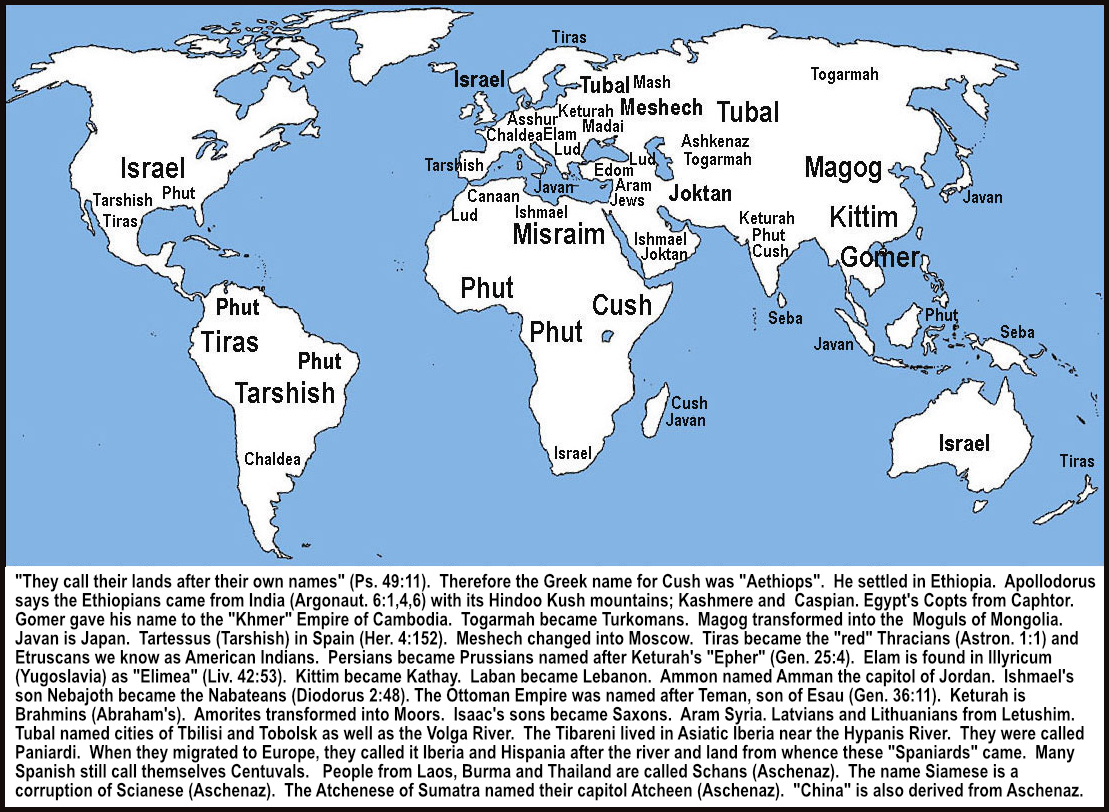The Amazing HISTORY of the World's RACES -- Ham's Children(Part One)
![]() here
did Noah's grandsons migrate (Gen.10)? What did they look like? Who are
they today? Was Noah "purebred" (Gen.6:9)? Did Ham (meaning
"burned") marry a black woman? Why was the Tower of Babel wrong? Did Japheth marry
an Oriental? Is Shem the father of Semitic people (Caucasians)? Are black men under a curse of SLAVERY (Gen.9:25)? Is Cush Ethiopia and India? Is Mizraim Egypt? Is Put the Nubians and Negroes? Is Canaan Phoenicia?
here
did Noah's grandsons migrate (Gen.10)? What did they look like? Who are
they today? Was Noah "purebred" (Gen.6:9)? Did Ham (meaning
"burned") marry a black woman? Why was the Tower of Babel wrong? Did Japheth marry
an Oriental? Is Shem the father of Semitic people (Caucasians)? Are black men under a curse of SLAVERY (Gen.9:25)? Is Cush Ethiopia and India? Is Mizraim Egypt? Is Put the Nubians and Negroes? Is Canaan Phoenicia?
Noah's Three Sons Mentioned in Secular History
The Sibylline Oracles speak of Cronus (Ham), Japetus (Japheth) and Titan (Shem) as the three sons of Noah (Cory's Fragments, p.52). Similarly, in the Hindu Mythology, "Sama," (Shem) "Chama," (Ham) and "PraJapeti" (Lord Japhet) are said to be born of Menu (Noah) or Satyavarman (Noah) (Asiatic Researches, vol.8 p.255; Moor's Hindu Pantheon, p.173).
According to Homer's Iliad, Neptune (Shem) says, "We are from Cronus (Saturn or Noah) and from Rhea sprung, Three brothers (Jupiter, Neptune and Pluto); When the universe was into three parts divided, each an equal share obtained, on casting lots. My lot it was thenceforth in hoary sea to dwell (middle regions to Shem which Canaan and Cush invaded): to Pluto (Ham), next, did fall the gloomy shades below (southern regions: Africa & India): Jupiter's (Japheth's) lot, the spacious sky in air and clouds." (northern regions: Asia & part of Europe) (Iliad 15:184-193). "The priests of Egypt, in the mysteries of Isis, call their country Chemia." (Ham) (Plutarch de Isis. et Osirid. 33) Bochart produces fourteen points of resemblance between Noah and Saturn (Faber's Horae Mosaicae 1:142).
The Persian account of the three sons of Noah are Oromasdes, Mithras and Ahriman. They are again repeated in the mythology of the Scandinavians where Bore was the great father, and the three sons Odin Vile and Ve (Edda, fable 3). The son of Ham (Ammon) was Cush (Saturn) and the son of Cush was Nimrod (Marduk).
Migration
The first civilization called Sumeria came from the name Shem. Chaldea is from Arphaxad. After the Tower of Babel, God commanded SEGREGATION when he "separated the sons of Adam" racially (Deut. 32:8). Cush (meaning "black") became Ethiopia and India. Mizraim is Egypt and Put is in West Africa. Were BLACK men cursed with SLAVERY (Gen. 9:25)? Canaan became Phoenicia. Ireland or Eire is named after the son of Judah and Shua the Canaanite called Er (cp. Gen. 38:1-10; 1 Chr. 4:21; Deut. 25:5-6). Is this why the IRISH provoke the BRITISH (Num. 33:55)? Gomer gave his name to the Khmer Empire of Cambodia. We can still find the "TAGARMA" Mountains in East Turkestan (Encyc. Brit. 27:423) named after the son of Gomer. The Turkomen of Asia are his descendants. Magog became the Moguls of Mongolia. "They call their lands after their own names" (Ps. 49:11). Madai is the Medes in the Ukraine today. They were "drawn from Media and planted along the Tanais" (Don River) (Diodorus Siculus 2:43).
Javan is Japan. Yes, Javan's son Kittim "shall afflict Asshur and ... Eber" (Num. 24:24) and one fulfillment of this prophecy was at Pearl Harbor since the United States is largely composed of German (Asshur) and British (Eber) immigrants. King David prophesied that God "breakest the ships of Tarshish with an east wind" (Ps. 48:7) and one fulfillment came when the Spanish Armada was wrecked by an east wind after it attacked Britain. Tartessus was a city in Spain (Herodotus 4:152). Tubal named the cities of Tbilisi and Tobolsk as well as the Volga River. Many Spanish call themselves Centuvals. Meshech became Moscow. "Woe is me, that I sojourn in Meshech ... with him that hateth peace" (Ps. 120:5-6). Does Moscow provoke war? Tiras became the "red" Thracians and Etruscans who are known today as American Indians.
The Prussians of northern Poland came from the Borysthenes (Dnieper) via the city of Prusa in Asia Minor but from Persia originally. Elam also became the Persians in Yugoslavia. The ethnic cleansing that occurred in Yugoslavia in 1995 was predicted by Christ. "Nation ("ethnos") shall rise against nation ("ethnos") (Matt. 24:7). Asshur is Assyria or Austria and Germany. God uses GERMANS to spank disobedient nations. "O Assyrian, the rod of mine anger ... I will send him against an hypocritical nation" (Isa. 10:5). Lud is Albania. Aram is Kurdistan and Jacob was half Aramean (Deut. 26:5). Rebekah was all Aramean (Gen. 25:20). True Israelites are therefore 3/4 Aramean and 1/4 Arpachshad. Arpachshad became the Chaldeans (Babylonians) in Italy. Yes, "Babylon the Great" sits on "seven mountains" (Rev. 17:5,9) in Rome. Ishmael is the Arabs. "His hand will be against everyone, and everyone's hand against him" (Gen. 16:12). Laban is the Lebanese. Moab and Ammon became Jordan whose capitol is Amman. Edom is the Ottoman Empire. God says, "I will make thee small among the heathen and despised among men" (Jer. 49:15). Keturah is the Brahmins (Abraham's) and northern Germans.
Why does the Bible deal mainly with Shem's WHITE descendants (Ex. 3:15) rather than BLACK Hamites or ORIENTAL Japhetic peoples? Because Isaac's sons are the Saxons. They are the white peoples of the United States, Canada, Great Britain, Scandinavia, Australia, New Zealand and South Africa and have received "blessings of heaven above" (Gen. 49:25) and blessings of "the deep ... beneath," "Blessed ... be his land" (Deut. 33:13) because Abraham was his father. We should not feel conceited about this, because we had nothing to do with how we were born. "For who maketh thee to differ from another? And what hast thou that thou didst not receive? Now if thou didst receive it, why dost thou glory, as if thou hadst not received it?" (1 Cor. 4:7). Instead, we should recognize the greater responsibility of serving the rest of humanity that comes with being a descendant of Abraham: "In thy seed shall all nations be blessed" (Gen 22:18). We should "not call any man common or unclean" (Acts 10:28) just because of his race or his father's sins. "God is no respecter of persons; But in every nation he that ... worketh righteousness is accepted" (Acts 10:34-35).
What Race Was Adam?
We must begin this study by figuring out who belongs to which race in the Bible. Let's take ADAM first. "ADAM" means "red blood" or "red mud" depending on which source is used. "ADAM" specifically means "to show blood (in the face)" when blushing or to be "ruddy" or RED according to Strong's Lexicon for "adam" (#119 & #120). From the name alone, it should be obvious that Adam wasn't BLACK or ORIENTAL, because BLACKS don't show blood because of skin pigmentation, and ORIENTALS have yellowish skin due to a layer of fatty tissue between blood vessels and skin surface (see p.1127, vol.1, Encyc. Brit., 1974). Only WHITES are "ruddy" or RED when they blush. "Edom" also means "red" and Esau (Edom) was Caucasian, so this is more proof ADAM was also Caucasian.
But there is another proof ADAM was WHITE. We know that Jesus Christ (the Word) was the God who actually made ADAM (John 1:3; Eph.3:9; Col.1:16) and he made ADAM in his own IMAGE and LIKENESS (Gen.1:26). So ADAM looked like the Messiah and God the Father since God said, "Let US make man ("adam" in Hebrew) in OUR image, after OUR likeness" (1:26). When "the word was made flesh" 4000 years later, he (Jesus Christ) was "the express image of His (the Father's) person" (Heb.1:3). But Jesus was a Jew (Heb.7:14; John 4:9; Rev.5:5) and therefore looked like a Jew. Judas had to identify Christ with a kiss because he looked so much like any other Jew of his day (Luke 22:48). Since ADAM looked like Jesus and Jesus looked like the average, purebred Jew, then ADAM must have resembled a Jew also. True Jews are WHITE, CAUCASIAN racial types.
The Bible reveals that every person, nation and race on earth today came from Adam and Eve (Gen.3:20; Acts 17:24-27; 1 Cor.15:45), so how did the BLACK and ORIENTAL races develop? Science has shown that there are varieties or "races" within every living species of plant or animal. We have a species known as DOGS. But within that species we find GREAT DANES, BULLDOGS, POODLES, CHIHUAHUAS, DACHSHUNDS, TERRIERS, etcetera. CATTLE are another species or "kind" if we use Bible terminology. But within that species or "kind" we have JERSEYS, HOLSTEINS, GUERNSEYS, ANGUS'S, HEREFORDS, SHORTHORNS, etcetera. We have a species known as CABBAGE. But within that species we find BRUSSELS SPROUTS, CAULIFLOWER, KOHL-RABI, KALE, and many other varieties. All of these races or varieties can interbreed with other races or varieties WITHIN the SAME SPECIES and PRODUCE FERTILE OFFSPRING. But they are distinct from eachother since they each are able to BREED TRUE to FORM and each has some UNIQUE CHARACTERISTICS.
The same is true for the three main races or varieties of the HUMAN species. BLACKS (Negroes, Coloreds), ORIENTALS (Mongolians, Yellow Race, Asians) and CAUCASIANS (Whites, Europeans) have intermixed and intermarried to create all the other varieties and blends of the HUMAN species.
Some people have taught that Negroes are BLACK because of sin or that BLACKS and ORIENTALS are pre-Adamite experiments or that they are the "beasts of the field" (Jonah 3:8; etc.). This is nonsense! The truth is that Adam and Eve WERE CREATED with sperm and egg cells containing the ORIENTAL and BLACK genes, as well as WHITE. So Adam's children were of ALL THREE racial types. "And God saw all that he had made, and behold, it was very good" (Gen.1:31). Therefore, ORIENTALS and BLACKS are "very good." God isn't racist! "For the Eternal seeth NOT as man seeth; for man looketh on the outward appearance, but the Eternal looketh on the HEART (attitude)" (1 Sam.16:7). "For who maketh thee to differ from another? And what hast thou that thou didst not receive? Now if thou didst receive it, why dost thou glory, as if thou hadst not received it?" (1 Cor 4:7). "Shall the thing formed say to him that formed it, why hast thou made me thus? Hath not the potter power (a right) over the clay, of the SAME LUMP to make one vessel unto HONOR and another unto ORDINARY USE?" (Rom.9:20-21 KJV & TCNT; cp. 2 Tim.2:20) "Shall the clay say to him that fashioned it, what makest thou?" (Isa.45:9).
Noah was "PERFECT In His Generations"
So the three primary races of man developed before the flood. But they didn't remain SEPARATED or SEGREGATED. After "the Most High DIVIDED to the nations their inheritance" and "SEPARATED the sons of Adam" RACIALLY, and "SET THE BOUNDS of the people" (Deut.32:8) and after God determined "the BOUNDS of their habitation" (Acts 17:26), "the sons of God" decided to INTEGRATE. These "sons of God," descended from the line of Seth (5:3) who was in "Adam's image" (CAUCASIAN), to Enoch (5:24), to Noah (5:28), etcetera, saw the daughters of men that they were fair; and they took them wives of all whom THEY CHOSE" (Gen.6:2) implying RACE-MIXING.
The "SONS OF GOD" could be referring to angels having sex with women and producing giants also. Yes, "sons of God" can refer to angels (Job 1:6; 2:1; 38:7; Ps.29:1; 89:7). But "sons of God" can also refer to men (Ps.73:15; Deut.14:1; 32:5; Hos.1:10).
In this instance it may have been both problems occurring. MEN APOSTISIZED and LEFT THE TRUTH by deciding to take wives THEY CHOSE, instead of taking wives GOD CHOSE (within God's guidelines of race and religion). Also the ANGELS SINNED. The worldwide flood was sent to destroy the resulting "CORRUPTED" (Gen.6:12) flesh. Since "all flesh" (6:12) includes animal flesh, the corruption included HYBRIDIZATION because animals can't be immoral. Jasher 4:18 says "Men in those days took from the cattle ... the beasts ... and the fowl ... and taught the mixture of animals of one species with the other, in order therewith to provoke the Lord." "The dog united with the wolf, the cock with the pea-fowl, and many others paid no heed to sexual PURITY" (TB Sanhedrin 108a &b).
The offspring of these mixed marriages are described as "GIANTS" who "became MIGHTY men" and "men of RENOWN" (Gen.6:4). In race-mixing this phenomenon is known as "HYBRID VIGOR." From the Academic American Encyclopedia we read that "Another advantage of hybrid plants and animals is that they tend to be (but are not always) LARGER
and HARDIER than their parents.... In animals hybrids tend to be STRONGER, HEALTHIER and FASTER GROWING than the parents.... As hybrids they produce MORE MEAT, EGGS, and MILK.... Hybrid corn is TALLER, HEALTHIER, and produces LARGER EARS of MORE UNIFORM kernels than other kinds of corn. It is also MORE RESISTANT to drought" (vol. 10, p.328). The same is true of humans! They become "GIANTS" and "MIGHTY MEN" and "MEN of RENOWN."
These became the gods and goddesses of pagan nations and cultures which was actually mere ancestor worship. Greek mythology is a good example. Japhet became JUPITER JAPETUS; Ham became AMMON; Javan is JANUS the ancestor of the Greeks; APOLLO the god of music, came from Jubal "the father of all such as handle the harp and organ;" for his brother Tubal-Cain, "the instructor of every artificer in brass and iron," we get VULCAN, god of the forge. Although not hybrids, other ancient figures were also worshipped: Noah is SATURN; The Greek TITAN is Satan. The HESPERIDES of the Gardens are Seraphim in Eden. Cherubim became GRIFFINS; the story of IPHIGENIA is stolen from Jephthah and his daughter; ORPHEUS is Abraham, the man of Urfa." When he goes to the infernal regions to recover EURYDICE, it reminds us of Lot and his lost wife. Samson is HERCULES who slew a lion with his bare hands. A king was orddered by the Oracle of Delphi to slay his son PHRIXOS but a ram came along and saved him. This is the story of Abraham sacrificing Isaac. ACHILLES could only die by having his heel wounded -- a parallel of the prophecy of "the seed" of the woman (Gen. 3:15). Tubal-Cain's sister married Noah. She was called in Hebrew Naamah. She got him drunk. Her name in Greek was NEMISIS -- the Greek goddess of revenge who brought all kings down to destruction (Gen. 4:22). She was the prototype of the harlot of Revelation sitting on Babylon holding a cup of wine for the world to get drunk.
NOAH "found grace in the eyes of the Eternal" (Gen. 6:8) because he "was a just man AND PERFECT IN HIS GENERATIONS" (v.9) or, in other words, as the Companion Bible states, "perfect ... without blemish as to BREED or PEDIGREE" (p.11). Number 8435 of Strong's Lexicon for the word "generations" mentions "descent," "family" and "history" indicating NOAH was PUREBRED in his ANCESTRY! He wasn't a HYBRID. All flesh had corrupted its pedigree, racially, except NOAH. NOAH was "without blemish" and "without spot" (Number 8549 of Strong's) in a racial context. God was about to destroy humanity and wanted to save a PERFECT SPECIMEN. Of course, NOAH was also spiritually righteous. He "walked with God" (v.9) and two can't walk together unless they agree (Am.3:3).
One of the primary sins that led to the flood was the WRONG KIND of 'MARRYING and GIVING IN MARRIAGE" (Matt. 24:37-38) as Jesus indicated. But how could the three primary races have passed through the flood when all were drowned except ONE FAMILY? Two of Noah's sons, who were unrighteous, married women of other races, but were saved because of him (Ez. 14:20). This can be seen in the diversity of Noah's sons. The Masoretic Text favors the KJV translation that "Japheth (was) the elder" (eldest). Shem was born 97 years before the flood (cp. Gen. 5:32 & 11:10) whereas Noah begat the first of his three sons one hundred years before the flood (cp. 5:32 & 7:11). Ham, being second born, is mentioned second (Gen.10:6-20). Since INTERRACIAL marriage began 120 years before the flood, it had already been going on for 20 years when Noah's sons were born (cp. Gen.5:32 & 6:3).
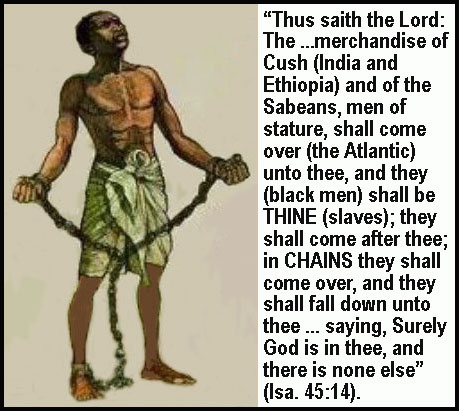
Are Black Men CURSED With Slavery?
"Semitic races have influenced, far more than others, the history of the world's mental progress; and the principal intellectual revolutions which have taken place are traceable in the main to them." -- George Rawlinson. The Jewish and Christian religions both came through the Semitic race and both Jews and Christians "are the light of the world" (Matt. 5:14). The children of Ham made little to no progress in civilization or religion and have remained the most primitive of the three branches. This is because Noah actually cursed Ham. Genesis 9:25 should be translated, "Cursed be Canaan's FATHER, a servant of servants shall he be to his brothers." Such relative words are often omitted and understood in Scripture, as in Matthew 4:21, James of Zebedee, for the SON of Zebedee; John 19:25, Mary of Cleopas, for the WIFE of Cleopas; Acts 7:16, Emmor of Sychem, for the FATHER of Sychem, as our English translation rightly supplies it from Genesis 33:19. Thus Goliath is put for Goliath’s BROTHER, as is evident by comparing 2 Samuel 21:19, with 1 Chronicles 20:5. So here Canaan may be put for the FATHER of Canaan, as the Arabic translation has it, that is, Ham, as the Septuagint here render it. Also Saadiah Gaon (882-942 AD) supplies it, as Aben Ezra relates. This makes sense since otherwise Noah addressed both Shem and Japheth while ignoring Ham his third son. Greek "mythology says KUMARBI (Ham) or CRONUS (Canaan) CASTRATED Uranus or Anu (Noah) so was cursed with being "a servant of servants" (Genesis 9:25-27).
We know that ALL of Ham's children became SLAVES, not just CANAAN. Egypt (Mizraim) is cursed in Ezekiel 29:15. God says, "I will DIMINISH them." Yes, after the Pharaohs were defeated, the Persians took over, then the Greeks, Romans, Mohammedans, Turks, French, and British. Egyptian rulers since 1953 have been Arabs. Egyptians (Mizraimites) are called 'SERVANTS" in Lamentations 5:8. Canaanites become "BONDMEN" in Joshua 9:23. Solomon also made them BONDSERVANTS (1 KI. 9:21). Later known as Phoenicians and Carthaginians, they were SUBJECTED by the Persians, Macedonians and Romans. Romans captured Carthage in 146 B.C. and made SLAVES of many thousands of Carthaginians. Canaan was bought and sold -- human "merchandise" -- the meaning of Canaan. The Phoenician Empire never rose to power again. Just as their father Ham had dishonored Noah's nakedness, so also Ethiopia (Cush) and Egypt (Mizraim) are made "NAKED ... with their buttocks UNCOVERED" as SLAVES according to Isaiah 20:4.
Libyans (Put) and Ethiopians (Cush) are UNDER the AUTHORITY of Antiochus Epiphanes in Daniel 11:43. "Thus saith the Lord: The ... merchandise of CUSH (India and Ethiopia) and of the SABEANS, men of stature, shall come over (the Atlantic) unto thee, and they (black men) shall be THINE (slaves); they shall come after thee; in CHAINS they shall come over , and they shall fall down unto thee ... saying, Surely God is in thee, and there is none else" (Isa. 45:14). Yes, the Bible predicted the slave trade. Not Canaanites, but CUSHITES are mentioned here.
Some commentators argue that Noah cursed Ham's fourth son because Ham emasculated his father to preserve his own inheritance. If Noah had had a fourth son or more, Ham would only get one quarter of the world or less rather than a third. The early Jewish commentator Rashi paraphrased Noah's rebuke of Ham: "You have brought it about that I cannot bear a fourth son to serve me; cursed, therefore, be your fourth son to serve under the descendants of these elder ones upon whom the duty of serving me will devolve from now on." It is related in the Padma-Pooraun that Satyavrata, whose miraculous preservation from a general deluge is told at large in the Matsya, had three sons, the eldest Jyapeti, or Lord of the Earth; the others were Charma and Sharma, usually pronounced Cham and Sham in the vulgar dialect. Satyavrata gave all the regions north of Himalaya, or the snowy mountains, to Jyapeti. To Sham he alotted the countries south of these mountains. But he cursed Cham, because when the old monarch was accidentally inebriated with strong liquor made of fermented rice, Cham laughed; and it was in consequence of his father's curse that he became a slave of slaves to his brothers (Hist. Hind. 2:45)
Harold Brackman quotes the Talmud's version of Genesis 9: "Ham is told by his outraged fathert that, because you have abused me in the DARKNESS of the night, your children shall be born BLACK asnd ugly; because you have TWISTED your head to cause me embarrassment, they shall have KINKY hair and RED eyes; because your LIPS JESTED at my expense, theirs shall SWELL" ("The Ebb and Flow of Conflict: A History of Black-Jewish Relations Through 1900" (1977 Ph.D. dissertation, pp.79-81).
Why Was The Tower Of Babel Wrong?
Soon after the flood, RACIAL INTEGRATION started to take hold again at the Tower of Babel, where the three races of men decided to dwell together by building a city "lest we be scattered abroad upon the face of the whole earth" (Gen.11:4). As God said, "The people are ONE, and they have all one language" (v.6). THEY WERE BECOMING ONE RACE! That was their sin! Their leader, Nimrod, was a BLACK man called "Shun" and his father was called "Chusou." ("Annals of the Bamboo Books," Chinese Classics by James Legge, 3:1, pp.114-115) Yes, "Belus (Nimrod) was EGYPTIAN." Osiris (Nimrod) is called "an INDIAN by extraction."(Diod. Sic. 1:28). "Osiris (Nimrod) was BLACK" (Plutarch's De Iside et Osiride, 2:359). Yet he married his mother Semiramis -- a WHITE woman ( Diodorus Siculus 2:6:6 & 2:8:7). His father was "Cush" (black) (Gen.10:8) -- thus he became a "mighty one" and a "mighty hunter" (10:8-9) through "HYBRID VIGOR." Horus, the son of Osiris (Nimrod) by Semiramis, "was of a FAIR complexion" (Plutarch, ibid. 2:359) again proving INTERRACIAL MARRIAGE. We can speculate that the flood came on the world (2304 B.C.) because of INTERRACIAL MARRIAGE and the confusion of languages dividing mankind into linguistic groups based on racial similarity may have also occurred (11:7-8) (c.2000 B.C.) because of the sin of INTERRACIAL MARRIAGE! So here now is the story of where each of Noah's great grandsons finally ended up.
Ham Is The Black Branch!
The name "HAM" literally means "BURNED" or "BLACK" in Hebrew. The Egyptian word "Khem" means "BLACK" (12:868a). The "land of Ham" is Egypt (Ps.78:51; 105:23; 106:22) and monuments testify that the country was called "Chem" or "Chemi" (in Coptic & Sahidic dialects). Certainly the offspring of Ham's marriage (Gen.10:6-20) leave no doubt that there was a BLACK/WHITE marriage between Ham and his wife. HAM'S portion was "beyond the Gihon (Geon is Nile in Ant.1:1:3), to the south." Jasher 10:25 says Sodom, Gomorrah, Admah and Zeboim (Gen.14:8) were "from the family of Ham." The name HAM took the form of AMMON (Gen.14:5) who was worshipped as an Egyptian deity AMUN or AMEN (1:860b). Do we mention his name at the end of our prayers? In east Sudan and the horn of Africa we find a tribe of Beja known as HAMRAN. Also in the same area is the BA-HIMA tribe (Brit. 1:329). An ancient city of Egypt was called AMMONIUM (23:648, E4). KHAMI South Africa (23:260), the KHAMTAS of Ethiopia (1:88b), KHAMBI India (14:376, Q7), the KHAMTIS tribe of NE India (15:771a), KHAM MUON and KHAM KHEUT both in Laos (14:498, D2) all indicate his descendants. Yes "they call their lands after their own names" (Ps.49:11).
Black men or Negroes dwell mainly between the Sahara and the Cape district , including Madagascar. The skin varies from dark brown to brown black, with eyes of the same color and hair usually black and always woolly. The skull is narrow, with orbital ridges not prominent, the jaws protrude, the nose is flat and broad, and the lips thick and everted. Two important branches of this family are the Bushmen of South Africa, small in stature and of a yellowish-brown color: the neighboring Hottentot is believed to be the result of crossing between the Bushman and the true Negro. Second are the large Negrito family, represented in Africa by the dwarf races of the equatorial forests, the Akkas, Batwas, Wochuas and others, and beyond Africa by the Andaman Islanders, the Aetas of the Philippines, and probably the Senangs and other aboriginal tribes of the Malay Peninsula. The Negroid type seems to have been the earliest predominant in the South Sea islands. In Melanesia, the Papuans of New Guinea, of New Caledonia, and other islands, represent a more or less Negroid type, as did the now extinct Tasmanians. The aborigines of Australia probably should be classed as Dravidians, a very remote blend of Caucasic and Negro man (9:851).
 copy.jpg)
Is CUSH Ethiopia & India?
CUSH first dwelt in Babylon as the KASHSHI or KOSSAE (7:666c), the KASSITE tribe (15:694a) from whom Nimrod sprang (Gen.10:8)
The Tower-of-Babel dispersion occurred about 2000 B.C. when CUSH migrated to India. An ancient Indian god was called KUSHIor KUSHUJA (ancestor worship). CUSH means "BLACK" in HEBREW, and the Greek name for CUSH was "AETHIOPS" (cp. Jer.13:23). In the Aryan Sanskrit the Sun is called KISORA, implying that it burns one dark. Egyptian monumental inscriptions call the land south of Egypt "KEESH" (modern Geez). Tell el Amarna tablets call this land "KASHI" (Ethiopia). The Meroitic Ethiopians are called KASU (9:847a). The "Ethiopians ... are even at this day, both by themselves, and by all men in Asia, called CUSHITES" (Ant. 1:6:2). Eusebius says the Ethiopians came and settled in Egypt in the time of Amenophis (Chron. ad Num. 402). He places Amenophis's reign so as to end about 431 years after Abraham's birth. According to Philostratus, there was no such country as Ethiopia below Egypt until this migration (Vit. Apollon. Tyanei 3:20); these people came, according to Eusebius, from the river Indus (Chron. ubi sup.), and planted themselves in the parts beyond Egypt southward. Thus began the kingdom of Ethiopia. Homer mentions two Ethiopian nations "in twain are divided ... Some toward the setting sun, and some toward the land of his rising" (Odyss. 1:23). See also Herodotus 7:70. Apollodorus says the African Ethiopians came from India (Argonaut. 6:1,4,6). Eustathius hints that the Ethiopians came from India (Dionys. p. 35). "'Abyssinian' ... is derived from the Arabic Habesh, 'mixed' and was a derisive name applied by the Arabs to the heterogenous inhabitants of the Abyssinian plateau.... The majority ... may be described as a mixed Hamito-Semitic people ... hair long and straight or somewhat curled and in colour dark olive, approaching to black" (1:88ab).
In Africa we find KOSTI (26:9, C3), KOSHA (26:9, C1), KASSALA town and province (26:9, D2) all in Sudan and KISIGO (11:771, B2), KISIWANI (11:771, C2), KISWERE town and harbor (11:771, C3), KISSAKI (11:771, C2), KISUKA (11:771, A1) and KASSUA all in Tanzania (11:771l, A2) and KISUMU town and Province (4:601, A2), KISIMAI (4:601, A2), KISMAYU (4:601, C3) and KASAGUNGA Mts. all in Kenya (28:45d) and KASAI Dist. (3:535c), KASONGO (6:923, D4), and KISALE Lake all in Zaire (6:923, D5) and KASAKALAWE (26:397b) and KASAMA both in Rhodesia (23:260, C1) and KISI KURUMAI (11:204, C5) and KISSIDUGU both in Guinea (11:204, C4) and KASANKA Cape (1:83) and KASAM River both in Ethiopia (1:83), We also find KISHI Nigeria (19:678, A3), KISSARIA Algeria (26:1034c), KISI Island Zambia (3:317d), KASAI River Africa (6:923, B3), KASKERA Somaliland (25:379, , D7), KASSAKERI, Mauritania (11:204, D2) KESE Togo (12:203, C3), KOS River Uganda (27:557, B1), and KOSI Bay, Lake and River S. Africa (27:199b; 28:1050b; 25:466, L6).
Some African tribal names are BA-KOSSI (Negro Bantu Transitional), KASSONKE (W. Sudan), BA-KUSSU (Congo Bend), KISAMA (Central to South Bantu), and WA-KISI (Eastern Bantu Negroids) (Brit. 1:329-330). Jeremiah 13:23 says, "Can the Ethiopian change his skin, or the leopard his spots?" This verse further proves that "CUSH" was "BLACK-SKINNED." William F. Albright says the Cushites "were strongly Negroid in type, as we know from many Egyptian paintings" (1:238, The Interpreter's Bible).
These KOSSAEANS of Ptolemy (15:694a) also migrated to INDIA and became known as "Asiatic Ethiopians" (Herodotus 3:94). "The eastern Ethiopians -- for there were two sorts of Ethiopians in the army -- served with the Indians. These were just like the southern Ethiopians, except for their language and their hair: their hair is straight, while that of the Ethiopians in Libya is the crispest and curliest in the world" (Herodotus 7:70; see also Strabo 1:111,119, 129). These ancient Myci (Her.3:93; 7:68) became the modern Mekran people of Pakistan and India (3:294b). Rashi says CUSH was India (Yoma 34 ; Baba Batra 74:6). "Their (India's) military nobility ... maintain that their great common ancestor was CUSHA or CUSH ... but we read in a special manner of two lands of CUSH, the Asiatic and the African. These were by the Greeks called the two Ethiopias ... but by the Hindoos, as by the sacred writers, they are denominated the land of CUSH within and the land of CUSH without.... from India to Armenia" (The Origin of Pagan Idolatry by Faber, 1:1:1:2-110). The Greeks and Latins called it SUSIANA and the Persians CHUSISTAN. Also the word "CAUCASUS" is derived fromCUSH via the Persian word "Coh-Cas" according to George S. Faber. Northern Ethiopia is called ERITREA because anciently the Persian Gulf was called ERYTHREAN according to Herodotus. Agathemerus, Dionysius, and the author of the Periplus call the whole Indian Ocean by this name CUSH was scattered from Babylon to India and Somalia and Ethiopia. Southern Arabians in the region of Zebid Yemen are also known as KUSH. Cush's portion was "toward the east" in Africa (& India) (Jubilees 9:1).
For example, we find Indian place names such as KUSHALGARH (14:376, D-E3), KUSBHADRA River (14:382, L9-M10), KUSASTALA River (14:382, H13), KUSI River (14:376, M6-7), KUSIARA River 14:376, O-P7), KOSALA (1:453c), KOSAMBI (14:396b), KISHANGARH town, fort and state (14:376, F6, D6;15:836a), KISHEN-GANGA River (14:376, E-F2), KISORIGANJ (14:376,O7), KASAI River (14:376, M8), KASALANG River (14:376, P8), KASHGAR State and KASHMIR State (14:376, G2). West and Central India are Dravidian CUSH while those in the deep south and northern Sri Lanka are darker and are known as Predravidians or Veddoids, directly related genetically to the Australian Aboriginees.
In Persia we find KUSHKUH (21:188, C3), KUSHK ZARD (21:188, B2), KISH Island (21:188, B3), KASHAN Province (21:188, B2), KISHLAK KHAR (21:188, B1), KISHM Island and town (21:188, C3), KESHEF-RUD River and in Afghanistan KISHM District (14:376, C-D1) and KASH River. A part of Persia is still called CHUSISTAN or KHUZISTAN.
"SEBA," the son of Cush, is the SABEANS in S. ARABIA (modern town is As Sabya) (Ant. 1:6:2). Isaiah 45:14 says the "SABEANS" are "men of stature" and Herodotus says Ethiopians are "the tallest ... people in he world" (3:20). This would include the WAHIM or BAHIMA of Uganda, the WATUSSI of Rwanda and Burundi, and the MASAIof Tanzania who are all very tall. The native name of the island of MEROE (near Egypt and Ethiopia -- Isa.43:3; 45:14) is SUBA (see Josephus) in SUDAN today! Some African tribes are called WA-SIBA (Eastern Bantu Negroids), ISUBU (Negro Bantu Transitional) and SAPE (Negroes) (Brit.1:329). In Mozambique is the SAVE River. Fra Mauro's Map (1457) labels south central Africa "SABA" (17:642) while Behaim's Globe labels Ethiopia "SABA" (17:644c). We find SEBDU fort in Algeria (1:651c) and a SEBU river in both Algeria (5:37c) and Morocco (18:851, D1) and a SEBUNGA district and SEBAKWE river in South Africa (25:466, H2). Dravidians (of INDIA and CEYLON) were anciently called "SIBAE" (Smith's Class. Dict., p. 145). An INDIAN god is called "SIVA" (ancestor worship). "SABAH" province, the city of SIBU, SAVU Island (17:466) E5) and SAVAI (17:466, F3) are located in Malaysia and SEBANGKA island (26:71, B-C2) as well as SIABA and SIABU towns all in Sumatra (26:71, A2). In Java is SEWANG (15:291) and SEWU Plateau (15:494c). We find SEBUKU island Borneo (4:257, C3) and the Bay of SEBANGAU Borneo (4:257, B3). In fact, both Micronesian and Polynesian races are dark-skinned and have straight black hair (Acad. Am. 16:34). "The traditions of many of the Polynesian peoples tend to make SAVAI, the largest of the Samoan Islands, their ancestral home in the East Pacific" (Brit.22:33d). In the West Indies we find SABA Island (28:544, F3). They came "from the Indian Archipelago" (22:33d). Australian aboriginees are Dravidian or SEBA also (9:851; 2:749a). In Fiji SAVU SAVU Point (10:335, B1) and in Samoa SAVAII Island (20:436, N8). In the Philippines many place names begin with SIB (29:727-728).
"Thus saith the Lord: The ... merchandise of CUSH ( India and Ethiopia) and of the SABEANS, men of stature, shall come over (the Atlantic) unto thee, and they (black men) shall be THINE (slaves); they shall come after thee; in CHAINS they shall come over, and they shall fall down unto thee ... saying, Surely God is in thee, and there is none else" (Isa. 45:14). Yes, the Bible even predicted the slave trade. It acquainted black men with the God of the Scriptures.
"HAVILAH," the son of Cush, is identified with India (Ant.1:1:3; Targum Yonathan). The town of Nagar HAVILI north of Bombay India and the town of CHWALA on the Caspian Sea indicate his presence. A city called HAVELIAN is located on the upper Indus River, between Pakistan and Kashmir. HAVILAH also settled in a district in upper Yemen called KHAWLANS (see Rabbi Aaron Marcus & the J.F.B. Commentary). They were known as AVALITAE in a town called AVALIS (modern Zeila) SW of Arabia Felix in Ethiopia on the Sea of Adan south of Bab-el Mandeb (Rhys: 1967, map 1). Strabo mentions the CHAULOTAIOI and HUWAILA of Bahrain. A Biblical Cyclopedia by Easie, p.315 calls "Colchis ... A country ... where the CHAVILAH of later times is found." Some African tribes are called MAHAFALI (Madagascar Bantu Negroids), FULA (W. Sudan), FELLAHIN (Hamito-Semites of Egypt) and FULLUM (Negroes) (Brit. 1:329).
"SABTAH," the son of Cush, is identified with SAUBATHA (Ptolemy 6:7,38) or SABOTA (Pliny 6:32; 12:32), an old trading city on the south coast of ARABIA. Ptolemy also mentions the SAPHTHA near the ARABIAN shore of the Persian Gulf. Targum Yonathan identifies SABTAH as SMADAI, a Cushite tribe, possibly the SOMALIS (Somaliland) or ASSAMESE (India). Josephus says SABTAH is the ASTABORANS (Ethiopia-- Strabo map 14). In Sudan is the SOBAT River (19:693 C6). In Morocco is the town of Ceuta which is SEBTA in Arabic (5:777b). SABATHU India (25:122d). Philippines SIBUTU Island and Passage (21:392, B8) are colonies.
"RAAMAH," the son of Cush, is identified as the OROMO tribe of Ethiopia. RAAMAH is INDIA'S god "RAMA" (ancestor worship). In Egypt too we have the sun-god RA. Strabo says the Rhammanitae are in S.W. ARABIA (16:4:24). The city of Regma (& Rums) are in S.E. ARABIA (Ptolemy 6:7:14). An African tribe is called REMO (W. African tribe speaking Yoruba) (Brit. 1:329). In S. Tanzania is the ROVUMA River (23:782a). In S. Africa is the RAMAKAHANE river (25:466, H3) and RAMAQUABANE (3:605c). In Somaliland we find RAML Cape (25:379, G3). In Nigeria is the RAMOS River (19:678, B5). In India we find six towns called RAMGARH, a river called RAMGANGA (14:376, H5), a river called RAMMAN (7:833d), and a third river called RAIMANGAL (14:382, N9), RAMBAT and RAM GHAT passes (18:649d & 14:382, F12), RAMA cape (14:382, E12), and many other place names beginning with the prefix RAM (29:652). Ancient maps place an island off the coast of India called RAMI (17:640ab).
"SABTECA," the son of Cush, is rendered "SEBAITIC mouth" when describing the Red Sea harbor of ETHIOPIA'S coast (Strabo 16:4:8; known as "SABAITICUM Ostium" on map 14). Targum Yonathan calls SABTECA "Zingain," possibly the "Zeugis" of Africa or Zanzibar. Also we find SAUBATHA (Ptolemy 6:7,38) or SABOTA (Pliny 6:32; 12:32), an old trading city on the south coast of ARABIA. Ptolemy also mentions the SAPHTHA near the ARABIAN shore of the Persian Gulf. We find the SOBAT River in S. Sudan (19:693, C6). In Morocco is the town of Ceuta which is SEBTA in Arabic (5:777b). SABATHU India (25:122d). However, in Borneo we find the SEBATIK Island (4:257, C2) and in the Philippines SIBUTU Island and Passage (21:392, B8).
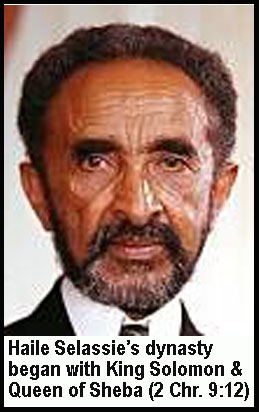
SHEBA, the son of Raamah, is another branch of the SABEANS (Ant.1:6:2) so is in YEMEN. INDIA & SUDAN branches are possible (see SEBA). In Somalia is the "Webi SHEBELI" River (25:379, D7-6) and in Ethiopia is the SHEB district (9:746a). The Queen of SHEBA was taught directly by Solomon (1 Ki. 10:1-10; 2 Chr. 9:1-9; Acts 8:27). She in turn taught the FALASHAS (meaning "exile") who were descendants of SHEBA. They are known as "Black Jews" because they keep the seventh-day Sabbath, clean and unclean meats, follow ritual purity and other laws of the Torah. They claim descent from Menelik, the reputed son of Solomon and the Queen of SHEBA. Emperor Haile Selassie 1 (who ruled Ethiopia from 1930-1974; see picture), who called himself "the lion of the tribe of Judah," is the most recent in a long line of Ethiopian royalty which came from the affair between King Solomon and the Queen of Sheba. Solomon gave her "all her desire, whatsoever she asked" (1 Ki. 10:13).
DEDAN, the son of Raamah, founded the city of Dedan in central ARABIA called "ed-dagan" up to 1200 A.D. and El-Ula today. He also gave his name to "DADEN" or "Aden," a port city and island on the south side of YEMEN. A branch migrated to western ETHIOPIA where the Judadeans live (Josephus) and where the DINDER River is located (19:693, D5). We find the DUDNA river in India (14:382, F10). The Targum Yonathan has M'zag which may be the Mazices of N. AFRICA. A tribe which sounds like "DEDAN" in West Africa is the Negro DENKERA. A tribe of Eastern Negroes is the DINKA (Brit.1:329-330) dwelling in S. Sudan (8:276d). We find the DADES river in Morocco (18:851, D3) and a DODO river in Nigeria (19:678, B5) and Cameroon (5:110, B2). In Malaysia we find the DODINGA town (17:466, F2), bay and isthmus (12:863d)
NIMROD, the son of Cush, was MERODACH (F.J. Los, Mankind Quarterly 7:151, 1967) or LUGALZAGGISI whose father was Ukush. "Lugal" means "large" (cp. Gen.10:10). He built eight towns in MESOPOTAMIA: Babel (which became the BABYLONIAN Empire), fifteen miles east of "Birs Nimroud." Erech (modern Warka in S. Iraq). Accad (which became the AKKADIAN Empire). In this region is a primitive monument 125 feet high and 400 feet in circumference, called "Tell Nimroud" by the Arabs. Calneh (Nippur or Nofar-Ninfi of the Talmud, Yoma 10a). The land of Shinar is the SUMERIAN Empire. Nineveh (capital of the ASSYRIAN Empire, "the land of Nimrod" -- Micah 5:6). Rehoboth (the ruins 3 1/2 miles southwest of Mayadin)(There is a tribe in Namibia called the Rehoboth), Calah (Nimrud ruins) and Resen (Aktispon or Ctesphon, Yoma 10a). According to a legend, "Nimrod had two sons, HUNYOR and MAGYOR. They married daughters of the prince of the Alans and became the ancestors of the two kindred nations, HUNS and MAGYARS or Hungarians." (Brit.10:389a). The Hungarian language most closely resembles the Sumerian of all modern languages. But Nimrod was black and Hungarians are white. (See also Brit.8:932c). A more reasonable claim is made by the Yoruba in SW Nigeria who are dark Negroid and claim descent from a Namurudu or Nimrod (The History of the Yoruba by Johnson, p.6).


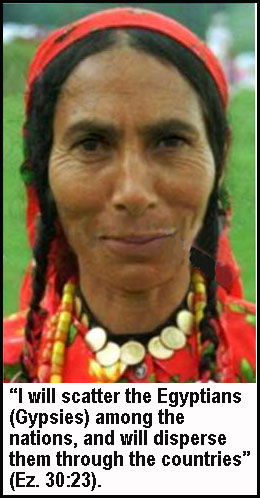
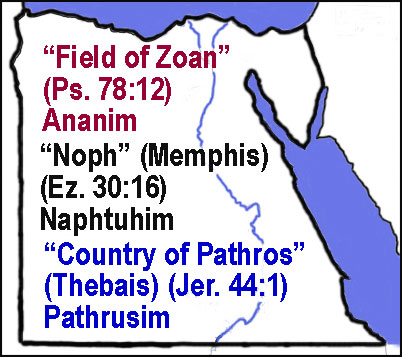
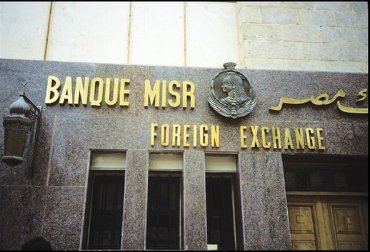
Is MIZRAIM Egypt?
"MIZRAIM" is EGYPT in Genesis 50:11 and the Hebrew MISRAYIM is commonly translated "EGYPT" in the Bible. The town of Fostat Egypt used to be named MISR or MASR (4:956d). In Arabic, MASR is the name of Cairo or of Egypt even today. Memphis is called MISR in Gibbon's Decline and Fall volume 5 inside cover. MIZRAIM means
"two lands," probably referring to Upper and Lower Egypt. But MIZRAIM also migrated to a land in S.E. Asia Minor called MUSUR or MUSRI mentioned in secular records. Shalmaneser III got Bactrian camels from MUSRI, indicating Asia Minor (see also 1 Ki.10:28; 2 Ki.7:6 and 2 Chr.1:16-17 where "Kue" is Cilicia. In Asia Minor we find MEZERE town (2:565, B2), MUZUR SU River (2:565, B2) and MUZUR DAGH Mt. (2:565, B2). In Crete MESSARA Plain and Bay (7:418, B1). In Syria we find the MUSRI District (18:628d) and MEZEIRIB town (20:602, E3). In Palestine EL MEZRAH (20:602, C3). In India we find MIZORAM, MUZIRIS (Kodungalur) (14:382, F14) and MASUR towns (14:382, F11) and MUSSOORIE (MASURI) city (14:376, G4). In Tibet is MAZAR TAGH (6:168, C2). In Afghanistan we find MAZAR-I-SHARIF (17:941d) In Arabia we find MIZRIM District (15:324c). In Sicily we find MAZARA town (15:26, D6) and MAZARUS River (24:607b) and MAZZARA DEL VALLO, Sicily (15:4, D6). In Italy MAZZORBO Island (27:50c). In Spain is the city of MAZARRON (25:530, E4) and in Peru MAZORQUE Island (21:266b). In Africa we find MAZARI Cape Morocco (18:851, E1), MESRATA, N. Africa (16:482a), MESURADO Cape, W. Africa (11:204, C5), MEZER Well, Sahara (23:1005a) and the MAZRUI family of E. Africa (4:605b). A tribe of Western Bantu Negroes is called MUSSORONGO (Brit.1:330).
But what race was "MIZRAIM"? Egyptian wall-paintings and statues (as well as many living descendants), skeletal remains and mummified remains all prove MIZRAIM or EGYPT had a CAUCASIAN ruling class but BROWN-skinned peasant class. This Caucasian dynasty of "all the kings of Egypt from Menes ... until Solomon, where the interval was more than one thousand three hundred years, were called Pharaohs" (Ant.8:6:2). That would make Menes about 2270 B.C. Mizraim was of the peasant class.
The "classical Greek and Roman writers commented on the relative darkness of the Egyptians.... Professor Virchow was the first to suggest that the red which the Egyptian artists used to portray Egyptian men reflected their sun-tan, since the skin of their women was painted pale yellow or even white. The women protected themselves from the sun (he theorized); the men did not; hence the difference in the color of their skin in Egyptian portraiture" (p.55, Race In Ancient Egypt & The Old Testament by Sayce and Peterson). However, Professor Virchow is mistaken. The Egyptian peasant class is always portrayed with black hair and black eyes and their uniformly red skin is a hereditary characteristic, not a sun-tan. The Greek and Roman writers knew more than Professor Virchow. The fair-skinned women are probably from the ruling class. The actual Pharaohs and ruling class of Egypt from its beginning when Menes ascended the throne in the first dynasty to about 1000 B.C. or even later were pure-bred Caucasian SHEM-ites and not from HAM'S lineage at all (p.74, Race In Ancient Egypt; p.28, The Makers of Civilization). The pharaoh of the Exodus was "Assyrian" (WHITE) (Isa.52:4). This is why Moses could pass as a "son of Pharaoh's daughter" (Heb.11:24). But the peasants were REDDISH-BROWN-skinned Mizraim. Deuteronomy 23:7-8 says, "Thou shalt not abhor an EGYPTIAN (# 4713 ""Mitsriy"); because thou wast a sojourner in his land. The children that arebegotten of them shall enter into the congregation of the Eternal in their third generation." This may be referring to the WHITE ruling class rather than the REDDISH-BROWN Mizraimites since the word "Mitsriy" is used to describe the Levite Moses also (Ex.2:19) whom we know was WHITE. Ezekiel prophesied that Egypt "shall be the basest of kingdoms ... they shall no more rule over the nations" (Ez.29:15) and "there shall be no more a prince of the land of Egypt" (Ez.30:13). After the Pharaohs were defeated, the Persians took over, then the Greeks, then Romans, then Mohammedans, then Turks, French and British. The Egyptian rulers since 1953 have been Arabs.
LUDIM, the sons of Mizraim, are located west of Libya according to their position at the head of the list of Mizraim's sons. But the Targum Yonathan renders Ludim "Givati" which could be derived from Gipt, Egypt or Copt, indicating EGYPT. We also find LUDAMAR West Africa (20:826b) and LUDHIANA India (14:376, F4). Did they get the name LUD from Shemite colonists who moved to N. Africa?
ANAMIM, the sons of Mizraim, could be located in Libya since a people of Cyrene called ANAMI are mentioned in a cuneiform text of the time of Sargon II (JPOS, I [1921], 191f.). ANAM named ANAMUR (Anemourium) in Turkey (2:760, E4), the ANAMBARA River, Nigeria (19:678, C4) and in Ghana we find ANUM (12:204b), ANAMABO (12:203, B4) and ANNAMABOE towns (12:203, B4). A branch went east to the ANAMIS River Persia (21:190b) and ANAMALAI town and Hills S. India (14:382, G14) and ANOMA River (4:738d). But the Targum Yonathan calls the ANAMIM "Martiori" or "Mariotai." These are the people from the district of Mareotis in lower Egypt which also has a town called Marea in it. We also find the name "Mauri" in Libya (Strabo, map 15) and we find brown-skinned Caucasian types in Polynesia today called "Maori" (Funk & Wagnalls, 19:78). Recently, "ANNAM" was a French colony in S.E. Asia (14:498). The Academic American Encyclopedia shows the Kingdom of ANNAM (Viet Nam) and Champa (Viet Nam) (2:255). The name "Champa" comes from "Ham" just as many Jews are named "Chaim" after "Ham." ANAM (BROWN) may have mixed with GOMER (ORIENTAL) to produce the brown, oriental Vietnamese hybrid. ANAMA Harbor Japan (15:156, P5), ANAMBAS Islands in Malaysia (17:466, B2), ANAMBARUIN-ULA Mts. China (6:168, E2) and ANONIMA (Namonuito) Island in the Pacific Ocean (20:436, D4-E3) all indicate his presence in the far east. In S. America is the ANEMBY River (Paranapanema) Brazil (4:440, F7) and ANAMAM Brazil (4:440, D2).
LEHABIM, sons of Mizraim, ( the LUBIM in 2 Chr. 12:3, 16:8 and Neh. 3:9) are the "Lebu" or "Rebu" of Egyptian inscriptions who gave their name to LIBYA where many still live. Josephus confirms this (1:6:2). "Lehabim" means "red people" and today we find people with "reddish brown" skin called "FULA." They are numerous from W. SUDAN all the way to SENEGAL on the Atlantic coast (Encyc. Brit. art. "Fula," vol.11). Most are in Nigeria today. The "LUBA" who live today in ZAIRE may be related (Acad. Am. 1:135). A tribe of Western Bantus is known as LUBOLO, and a central Bantu-Negroid tribe is called BA-LUBA. A Negroid tribe of West Sudan is LEYBU (Brit. 1:329-330).
NAPHTUHIM, sons of Mizraim, designate the worshippers of PTAH (ancestor worship) who were Memphites and whose capital was "NA-PTAH," (the habitation of PTAH) contracted into NOPH (Isa.19:13, Jer.2:16, etc.) (Memphis -- 18:106b). In S. EGYPT we find the capital city of NAPATA (9:40, B4). In Nigeria we find NUPE Province (19:678, B-C3).
PATHRUSHIM, sons of Mizraim, dwelt in PATHROS, or Upper Egypt. "Pathros" means "people of the south land" (upper Egypt -- higher elevation) in Egyptian. This is the area around Thebes which has been called "Nomos Phaturites" on occasion. Colonies may be in PATRI India (14:382, G10), PATHYAR India (14:625d), and PATRAS (Patrae) town and Gulf both in Greece (12:440, C2 & 12:424, C2). They moved to Crete (see below).
CASLUHIM, sons of Mizraim, are the Nasamones (LXX), a powerful tribe of LIBYANS. Herodotus affirms that the Nasamones are Libyans (Histories 2:32). Targum Yonathan calls the "Casluhim" "Pentpoletai," probably "Pentapolis" (Cyrenaica) in Libya also. They moved to Crete (see below). A colony migrated to Persia and named KIZIL River (Kotur) (15:778d) and KIZIL ROBAT (26:305, F2) and KIZIL-AGACH Bay Caucasia (23:874, II F4). In Turkestan (Russia east of the Caspian) we find KIZIL-ART Pass (26:910d), KAZALINSK (27:420, C3). KAZALA (15:703d), and KIZIL KUM Desert (27:420, C4-D3). In Turkey we findKIZIL-DAGH Mt. (2:565, B2), KIZIL DIZE (3:555a), KIZLI HISSAR (2:760, F4), and the KIZIL IRMAK River (2:760, G2). In Greece the KIZIL-DELI River (8:16b). In India we find KIZIL-JILGA (14:376, H2). In Russia we find KIZIL-TASH Bay (23:874, I F4), KIZLYAR (23:874, II E2), KOZELETS (23:872, D5), KOZLOV (Tambov) (23:872, F5) and KOZELSK towns (23:872, D-E5), and KOZELSK District (3:468c). In W. China (E. Turkerstan) KIZIL-DAVAN Pass (27:423a), KIZIL SANGHIR Mts. (6:168, D1) KIZIL-RABAT (14:376, F1) and KIZIL-SU River (6:168, A2).
"PHILISTINES," sons of Mizraim, came from the island of CAPHTOR (CRETE) according to secular and biblical history (Deut.2:23; Jer.47:4; Am.9:7; Brit.9:85d; & Tacitus Hist. v.2). From there they migrated to PALESTINE in the twelfth century as PHILISTINES or PELETHITES and then to PHELLUS (17:152a) and PALATIA Asia Minor (18:443a), PALATI Greece (19:318b) and PALATITZA Macedonia (17:220a), and PHALASARNA Crete (7:425d) A colony migrated to ETHIOPIA as the FALASHAS and to Italy where we find the three towns of POLISTENA (4:964d), PALESTRINA (15:4, D4) and PALESTRO (14:916c) and PALATINA District Rome (23:589c). A mouth of the Po was anciently known as the Fossae PHILISTINAE (Tacitus Hist. 3:9). We find PILIS Mts. in Hungary (13:894d) and the POLISTA River in NW Russia (23:872, D4). In NW India were the PHOLOSINA Mts. (13:514c). In Germany is the PALATINATE Province (20:594b) and Upper PALATINATE District (3:543c). Others stayed in PALESTINE (Zech.9:5-7) and today are known as "Palestinians."
"CAPHTORIM," sons of Mizraim, gave their name to CAPHTOR (Crete) (21:404c) since they, like the Philistines, came from Pathrusim and Casluhim (Gen.10:14). They went to CAPPADOCIA (LXX & Targum; 21:404c) and to EGYPT as COPTS (7:113a; 9:90d) naming COPTOS Egypt (9:40, B2) and to PALESTINE as CHERETHITES ("CRETANS" -- LXX) (see Deut.2:23; 1 Sam.30:14; Ez.25:16; Zeph.2:5). Paul mentioned a character flaw in these people when he said, "The Cretans are always liars, evil beasts, slow bellies (lazy gluttons)" (Titus 1:12). Today that remark would be called RACIST! According to the Midrash, a branch of the Caphtorim became the PYGMIES of the CHAD, C.A.R., SUDAN area. The "KAFIRS" of INDIA may be another branch (see Acad. Amer. 2:243). Ptolemy 4:5 mentions "COPTOS town" in N. Africa.
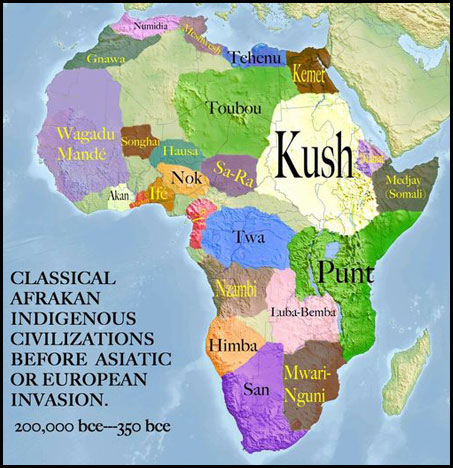
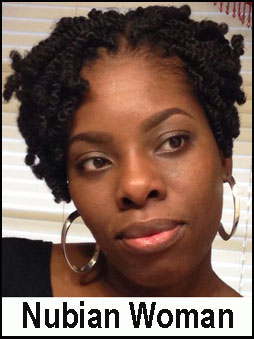
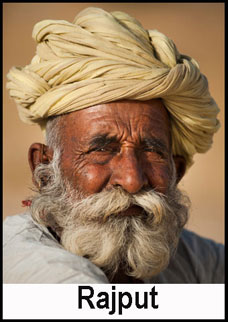
Is PUT the Nubians and Negroes?
"PHUT" is the BLACK African. "PHUT" named the river "PHUT" in Western NORTH AFRICA (see Pliny's Natural History). Ptolemy 4:1 mentions the "PHUTH river" in MOROCCO. Wordsworth said in 1872: "PHUT was still given to a river of Mauritania and all the region around it in the fourth century (S. Jerome)." Since American slaves came mainly from the WEST COAST of Africa and occasionally from Nigeria and the Congo, this indicates that the slaves were descendants of PHUT. In Liberia we find the coastal tribe of PUTUS (16:542a). In Coptic (Ancient Egyptian), LIBYA is known as PHIAIT (Both LXX and Antiquities 1:6:2 agree.). Everywhere "LIBYA" is found in Scripture, the Hebrew is "PHUT."But LIBYA is now Lehabim. PHUT moved on. "PHUT" is also identified as SOMALILAND (and YEMEN since on both sides of the Red Sea) via the Egyptian "PUNT" (or "Pwent") reference by Ebers. Confirmation comes from a Babylonian tablet mentioning "PUTU-yaman" (Put Yemen) and the Persian inscription of Naash-i-Rustem naming PUTU (meaning SOMALILAND). PHUT settled in CENTRAL AFRICA (Jubilees 9:1; from LIBYA). The BAFUT (a.k.a. Fu, Fut, Fufe) language in the Niger-Congo region may be derived from PHUT. Between Egypt and Ethiopia proper, we find a people called "PET" by the Egyptians (Nubians of SUDAN) (pp.195-197, Rawlinson's Origin of Nations). These Nubians (PHUT) served in the Egyptian army (Jer.46:9; Nah.3:9). We find the PATTA Island and town in Kenya (4:601, C3). Ptolemy 4:5 mentions "PHTHEMPHUTHI nome" in N. Africa as well as "PHTHENETU nome". A colony of PHUT sailed to South America naming the "PUTUMAYO River" there as well as the POTY (4:440, I3) and POTENGY Rivers in Brazil (19:265b). The PETEN Lake and Plain are in Central America (5:678, A-B2). The Zuni Indians of the U.S. are descended from Libyans (Barry Fell, America B.C., pp.174-191). In South Africa today is the country called BOPHUTHATSWANA (p.500, Reader's Digest Almanac 1981) and PITSO town (3:504d). The BUTWA people in Zimbabwe and BOTSWANA and the two tribes of the Tswana, the BATWANA and BATALOKWO all indicate PHUT. A stone in the wall of Deir-el-Bahari, close to Thebes, mentions an expedition of Queen Hatshepsut (c. 1493 B.C.). In this inscription, the Queen of PUNT is shown to be of the HOTTENTOT race. (History of the Indian Ocean by Toussaint, pp. 13-14). A branch migrated east becoming the RAJPUTS (meaning "chief of Put") of INDIA. In general PUT was in N. India while Cush was in central and S. India. But many place names in India and Ceylon begin with PUT. For example, PUTTALAM (14:382, H15), PETTAH (6:713c) and PATANA (5:779d) all in Ceylon and PAT (26:726b), PITIANI River (14:376, B7), PETARO (14:376, B-C7) and PATNA (PATALIPUTRA) (14:376, L7) all in India. Arabs took slaves from central Africa to Arabia, Iran and India (Funk & Wagnalls, 24:17). The BrahmaPUTra River in India is another proof of their Asiatic location (cp. Ez. 26:10; 38:5).
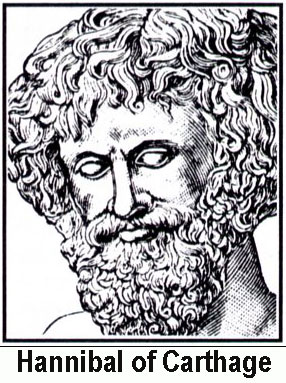
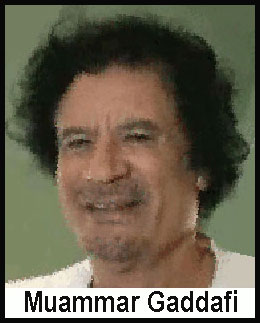
Is CANAAN Phoenicia?
"CANAAN" is scattered all around the Mediterranean (see any article on MOORS, PHOENICIANS, etcetera). They live in CANAAN, S. ITALY, S. SPAIN, S. PORTUGAL, ALGERIA, TUNISIA, MAURETANIA, MOROCCO, MALTA, LIBYA, ARMENIA etcetera. Canaan's portion was "to the west" of Phut (Jub.9:1) or on the west coast of N. Africa. Called "Agenor" by the Greeks, he gave his name to the AEGEAN Sea. Greek sources like Philo of Byblos and Stephanus of Byzantium mention the "KNA' (AN)" and coins from PHOENICIA bear this name "KNA" or "KNAAN." Phoenicians "called themselves Canaanites ... such is their name in the Amarna tablets, KINAHHI and KINAHNI ... Hecataeus (Fr. hist. gr. 1:17) (says) that ... "CHNA ... was afterwards called Phoinix" (Encyc. Brit. 11th 21:450) (cp. Isa.23:11; Obad.20; Zeph.1:11). We find the KINANAH tribe in Egypt (9:99b) and KANAKH Caucasia (23:874, II C3), KHANABAD town and River Afghanistan (1:307, E1;14:376, C1), KHANA District Asia Minor (18:180b), KHANA, India (14:376, M8), KANA Benin (11:204, G5), KANGARI and KANKAN Mali (11:204, D4). Canaanite clan-names "such as ACHAN, AKAN, JAAKAN, ANAK (generally with the article prefixed), KAIN, KENAN" (5:140d) are also found such as ANAKLIA Caucasia (23:874, II B2) and ANAKALANG Mt. Malaysia (17:466, D 5-4) and ANAKAPALLE India (14:382, K11). These sons of ANAK were strong giants (Deut. 9:2). Philologists call Canaanites a Shemitic race because of their language. But language is only a test of social contact. Canaanites are Hamitic. Also, since Benjamin, Manasseh, Ephraim, Zebulun, Asher, Naphtali and Dan didn't drive out the Canaanites from the land (Judges 1:21-36), we can assume CANAANITES intermarried with and live with Israel today wherever Israelites are.
The word Canaan means "merchandise". The original Hebrew word for "Canaanite" in Zechariah14:21 is "trafficker" because they were great bankers and merchants of old. They were the middle men for all trade goods. This tendency still exists today with the SICILLIAN MAFIA who are Canaanite. SODOM and GOMORRAH were also Canaanite (Jasher 10:24-25). Canaanites were morally depraved (Lev. 18:24; 20:23).
The GAELS of Scotland, GAULS (Roman forms) of France, and KELTS (Greek form) of Ireland, CELTIBERI of Spain and PortuGAL were mostly Canaanites and the Kymry, Belgae or Brits were the Israelites. Israel was known as Beth Khumri in Assyrian inscriptions from King Omri (1 Ki. 16). As Hosea prophesied, northern Israel would be known by the name "Gomer" (Hos. 1:3) which is where Wales got the name "Cambria" and English counties got the names "Cumberland" and "Northumbria." Appian mentions "the Cimbri, a people of CELTS" (1:625). The Belgae were known as Kymry also. Now GAL is a frequent element in local names throughout Canaan and Israel, as in GALAAD, GILEAD, GALILEE and GILGAL. The Hebrew word GELILOTH ("circles") is used five times in scripture; twice in the general sense of "coast" or "border" and three times relating to the course of the Jordan, the valley of which was at one time the headquarters of the inland Canaanites. The twenty cities given by Solomon to Hiram, King of Tyre, were called GALIL; they were also known as the "district of the Gentiles" -- possibly from the number of Canaanites who remained unexpelled from the cities of that part of the country. In this way, GAEL may have easily become a Canaanite name, perhaps referring to their occupation of the sea coast. Canaanitish immigration to Ireland took place about 745 to 677 B.C. and the colonists of Ireland gradually formed settled governments. Four kingdoms took their rise -- the later provinces of Ulster, Leinster, Muster and Connaught; the last three settled by dark-haired CANAANITES; Ulster settled by the Tuatha De DANAAN and the Milesian Scots (sons of MAHOL of JUDAH -- 1 Ki. 4:31), both ISRAELITES. Southern Wales is also occupied by dark-haired CANAANITES. SIMEON married a CANAANITE girl (Gen. 46:10). and probably settled in Wales. There is evidence in Ulster of SIMEON in such tribal names as Semrighe, Tuath Semonn, Senmogad, Seneran. The Irish reputation as "hot-tempered" could come from SIMEON blood (Gen. 49:6-7). In the eastern counties of England we find Simeni. In Connaught, as in Britain later, we find the name Damnonii and in North Ireland the Darnii, the Damnii of Argyle, the Demetae of Cambria. As time went on, the Scots made predatory raids from Ireland to the coast of Britain and dominated Wales, Cornwall and the Isle of Man. In the third century A.D. the Irish Scots had conquered southwest Scotland (Argyle) and the Hebrides, and the lowland counties except the district of GALLOWAY, which was a settlement of the CANAANITES. The whole Highland district and the neighboring coast was occupied by the Canaanitish Phoenicians or GAEL. BY 250 A.D. ISRAEL possessed all of south Britain and the lower half of north Britain and northern Ireland. South Ireland and northwest Scotland were CANAANITE. We find GALWAY in western Ireland. These areas are where Roman Catholicism is strongest with its pictures and molten images. From these same areas have come the modern insurrections of the FENIANS (Phoenians, Phoenicians) and the agitation for Home Rule. Irish tenants abusing English landlords, Gladstone's Home Rule Bill, the Moonlighters, assassinations, bombings and the IRA. Numbers 33:52-56 says "those which ye let remain shall be THORNS in your sides and shall VEX you in the land wherein you dwell." Joshua 23:13 says, "they shall be SNARES and TRAPS unto you." Many potato farmers in Ireland emigrated to America and became poor railroad workers to fulfill the prophecy saying "a servant of servants shall he be unto his brethren" (Gen. 9:25-27). They have become "hewers of wood and drawers of water" (Josh. 9:23).
Iberians and Phoenicians came to Ireland via Spain. Hence the Spanish word for Phoenician is "FENICIO" which is akin to the Irish name "FENIAN." The Irish language is identical in all respects with the Phoenician language having an alphabet of sixteen letters. Irish are probably ARVADITES (Ardmore and Arvagh, Ireland) and ARKITES (Arklow, Ireland).
JUDAH married Shua, a Canaanite girl, contrary to God's law (Deut. 7:3). She gave birth to three children: ER, ONAN and SHELAH. ER and ONAN were wicked and God executed them (Gen. 38:1-10). It then became the responsibility of SHELAH to marry TAMAR and to name her first-born son after his dead brother ER (Deut. 25:5-6). He did this (1 Chr. 4:21) and ER'S descendants migrated to Ireland and named it ERIN or EIRE or "ER'S land." The ancient Irish language was ERSE -- a combination of Hebrew and Phoenician. Some ERSE "characters closely resemble the lettering on the Moabite Stone (c. 809 B.C.), and those on the Siloam inscriptions (725 B.C.); and are almost identical with the Anglo-Saxon of the Earle MSS.; which race also came from the stock of Abraham" (JD Massey Tamar Tephi).
Also the name SHELAGH is a popular Irish and Scottish name. Girls are also known as SHELAHS. The Irish are noted for their famous "IRISH LINEN" and this was a distinctive feature of this family. As 1 Chronicles 4:21 says, "The sons of Shelah, the son of Judah, were ER ... the families of the house that wrought FINE LINEN." In southwest Britain is the TAMARUS River.
What did the Canaanites look like? Moors (or Canaanites) have "black" eyes and hair and "skin the colour of coffee-and-milk" (LIGHT TAN or "WHITE") (Encyc. Brit. 18:813, art. "Moors"). William F. Albright says, "All known ancient races in the region (of Palestine) ... belonged to the so-called 'white' or 'Caucasian' race" (1:238, The Interpreter's Bible). A Phoenician from the tomb of Rameses III has yellow-colored skin (p.102, Race in Ancient Egypt). Hebrews and Canaanites were "basically similar to eachother as far as race was concerned" (p.19, Fischer's Racial Origin ... of The Hebrews).
The danger of Hebrew and Canaanite intermarriage is very real in our modern society. Both branches look similar enough. Both look Caucasian and white-skinned even though Canaan is a HAMITIC branch and Israel a SHEMITIC branch. Both live together in the United States. No ministers are shouting a warning or educating their young people. "Neither shalt thou make marriages with them" (Deut. 7:3). The heredity is not compatible. It mongrelizes any purebred SHEMITE heredity. Who knows if birth defects and mental retardation in the children of such unions might be one reason God forbade this inter-racial marriage? Israelite women who would be horrified at marrying a BLACK man of HAM, are caught unaware by the WHITE-skinned Canaanite, whose only identifying feature is usually BLACK CURLY HAIR or an Irish ancestry.
"SIDON" or Zidon, the son of Canaan, became the capital of PHOENICIA, so the "Sidonians" (Judges 18:7) are found in LEBANON, CYPRUS, SICILY, SARDINIA, SPAIN and N. AFRICA. These are the Phoenician colonies of history (Acad. Amer. 15:250). Even when TYRE later grew to greatness (Josh.19:29), the kingdom was still called "Sidonian" (1 Ki.16:31; Homer). Thus Ethbaal king of Tyre (Ant.8:13:2) is called king of the Sidonians in 1 Kings 16:31, although possibly MEDITERRANEAN and TYRRHENIAN got their names from TYRE (rather than "Tiras"). But see under LUD for another possibility. The name "Phoenicians" may mean "blood red." "The Canaanite sailors were spoken of as the "red men" on account of their sunburnt skin" (Encyc. Brit. 11th 21:450). Thus they looked CAUCASIAN. The "SIDONES" of BULGARIA (Strabo map 6) may be colonies. In prophecy, when the Bible speaks of Tyre, it means ROME since Juvenal said, "the river Orontes (in SYRIA) has long flowed into the Tiber (in ROME)" (Juvenal 3:62). Also the Canaanites (Sidonians & Tyrians) dwell in southern ITALY today. Ptolemy says the "Bastuli" of Spain are "also called Phoenicians" (2:3) and here we find "Carthago vetus" also (2:5). Ptolemy 3:4 mentions "Phoenicodes island" near Sicily and 3:13 mentions the town of "Phoenice" in Epirus and in Crete "Phoenicus harbor" and "Phoenix town" (3:15). Perhaps the MINOAN Civilization on Crete was also Phoenician. Furthermore, the king of TYRE thinks he is god (Ez.28) and many Roman emperors and Popes have thought this too.
HETH, the son of Canaan, became the HITTITES (Gen.15:19-21; 23:1-10; Num.13:29) of Palestine. These were not Shemite KHETTI in Asia Minor or Japhetic KHITTIM in Greece, Crete, Cyprus and Rome. They intermarried with Esau (Gen. 26:34) and later converted to Judaism (Josephus' Ant. 13:9:1). Others may have been absorbed by the Assyrians and Israelites. The "Hittites" of Syria or Asia Minor were different from those of Palestine (p.107, Keller's The Bible As History). They moved to ATTIKA Greece, CATAONIA Turkey, CATANIA Sicily, CATALONIA Spain and CASSIDERIDES and CAITHNESS Britain and CATTEGAT Denmark (Waddell's Makers Of Civilization). In Germany today we find ETTAL (19:946b), ETTENBACH river (9:862d), ETTENHEIM (9:862d), HATTINGEN (11:808, 1 K6) and ETTLINGEN (11:808, B4) as well as HESSIANS. The Frankish tribe known as HESSI is derived from the CHATTI. As Walther Schultze says, "Alike both in race and language, the CHATTI and the HESSI are identical" (13:410a). The Sioux Indians of North and South Dakota were called "CHATTI." Their noses were long and hooked. They defeated Custer. Possibly the "Het" Indians of Argentina may be a colony. Hessians were warlike and generated fear (2 Ki.7:6-7). The MACAE Canaanites originated the MOHAWK haircut (Her. 4:175) and others sleep on GRAVES of ANCESTORS for prophetic DREAMS (4:172). Carthaginian Canaanites traveled to a country beyond Gibraltar and invented SMOKE SIGNALS to communicate (Her. 4:196). PYRAMIDS are common to both North Africa and central America. R.B. Madison says, "Berbers (Canaanites) have the same ... ANIMAL LEGENDS ... ARROWHEADS ... Wore FEATHERS in their hair, and wore FRINGED leather clothing ... like the native American" (Berber Project, p.14).
JEBUSITES, the sons of Canaan, inhabited the Jerusalem area (Joshua 15:63; Judges 19:10) and then went to EBUSUS Island off the coast of SPAIN (Strabo map 3) and other Phoenician colonies possibly. Ptolemy also mentions "EBYSSUS" Island and town (2:5). Among the Yorubas "are found persons with lighter skins and features." One of their tribes is called "JEBU" in the Togo and Benin area (28:936d). In Senegal is the town of JIBO (11:204, F3), in French Somaliland is the town of JIBUTI (25:379, C2) and in Nigeria is the town of JIBU (19:678, D3). In Somalia is the JUBA River (25:383c).
AMORITES, sons of Canaan, inhabited PALESTINE (Gen.15:16) and are the AMURRU of the Amarna Letters who lived east of Phoenicia in the mountains (5:141b). Today they are known as the MOORS of Morocco, Algeria, Mauritania, Portugal, Spain, Sicily, Italy and Brazil and the MAORIS who are an eastern branch of AMORITES in New Zealand and MAURITIUS. .and a tribe of AMARAR "Arabs" living "on the west side of the Red Sea" in Sudan and Egypt (1:781a), the N. Median tribe of AMARDI (18:21a) and possibly the tribes of hybrid AMARAN in Somaliland (25:383c) and AMORO GALLA in Ethiopia and Kenya (11:414b). In Algeria are the AMUR Mts. (1:643, B2) and AMORA town (1:643, C2). In Sudan is AMARA town (26:9, B1). In Ethiopia is the AMARA River (25:869b). In Nigeria is AMAR town (19:678, E3). In Mozambique is the AMARAMBA Lake (23:782b). In Portugal AMARANTI (21:92b), AMARELLA Mt. (25:530, A2) and AMARANTE town (22:139b). In Brazil AMARANTE (4:440 (H3) and AMARGOSA towns (4:440 (I5). In Peru AMARU-NYU River (4:167, A2). In Argentina AMARGA Lagoons (7:141a). In Cyprus AMARGETTI (7:700d). In Italy the AMARO Mt. (15:4, E3). In Greece AMARYNTHUS (1:780c). In Turkey Meadows of Gold by Al Masudi mentions AMORIUM a city in central Turkey. Ptolemy 5:2 mentions AMORIUM in Phrygia and AMORGUS island just west of Turkey. The Phrygian Dynasty of Rome (A.D. 820-867) is called an AMORIAN Dynasty (23:511d). The Britannica also mentions AMORIUM (5:34d) and AMORGOS Island (2:760, B4). The AMORGES people "in Caria" Turkey were probably AMORITES (7:833c). In Syria is EL AMARA suburb of Damascus (7:785a). In Iraq we find the town of AMARA (26:305, G3) and KUT-EL-AMARA (26:305, F3). In Persia we find AMARLU town (12:6d) and AMARDUS River (Sefid Rud) (21:188, A1). In India we have AMARAVATI (14:382, HI-11) and AMARWARA (14:376, H8). In Russian Asia we have the AMUR District (25:10, H3-I4) and river (17:553, E3-2). In Burma AMARAPURA (4:840, E4). In Malaysia AMURANG town and bay (17:466, E2; 5:596d). In the Pacific Ocean AMARGURA Island (27:4a). In New Zealand AMURI city, county and bluff (19:624, D5).
GIRGASHITES, the sons of Canaan, came originally from Carchemish on Euphrates which was anciently known as GIRGAMISH (13:534d), moved to Palestine and then were displaced from PALESTINE and so moved to Northern AFRICA (Rashi on Ex.33:2 & 34:11; Yerushalmi, Shabbath 6:31), specifically CARTHAGE (founded by Phoenicians!) where we find frequent personal names such as "GRGSHY," "GRGSH," and "GRGSHM" in the vowelless Punic texts there. The ZAB Rivers of Mesopotamia may have given their names to the ZAB Mountains of Algeria (2:859b). Another branch of the Girgashites may have become the "GARGARIANS" who moved to the Caucasus region (Strabo) and then named Russian GEORGIA. Other names which may be related are "GERGESENES" (Matt.8:28, KJV) and "KIRKISHATI" (Assyr. Tab.). Another probable location is western ASIA MINOR where we find the town of "GARGARA" (16:407a) and the "GARGARUS MT." (27:316a) and GERGIS (27:315d) and where the people were known as "GERGITHIANS" (Strabo 6:35,139). The Amazons, who founded "Smyrna, Ephesus, Sinope, Paphos," "once a year, in order to prevent their race from dying out ... visited the Gargareans, a neighboring tribe" (Encyc. Brit. 11th, 1:790). Pliny 5:115 says they're real people. Ptolemy 3:1 mentions "GARGANUS Mts." in S.E. ITALY where we also find GARGANO Prom. (15:4, F4) and 4:6 mentions the "GIRGIRI Mts." in N. AFRICA. In Malta we find the town of GARGUR (17:508, B2). In Hungary we find the GYORGYO valley (27:212a) and the GORGENY Mts. (3:4, I3). The city of Agrigentum in Sicily was anciently called GIRGENTI (15:4, D6). In Egypt we find the GIRGA Province (9:29a) and GIRGA town (9:40, B2). In Pakistan is the city of GARGAROK (14:376, A5) and the Caspian Sea was anciently called JURJAN Sea (5:452d) with the GURGANJ kingdom to its east (15:778a) or JURJAN (see Gibbon). In Algeria are the JURJURA mountains (1:643, C1). In Greece is the town of GARGALIANI (12:424, C3). In Spain we find the town of GARGANTIEL (25:530, C3). Carthage, N. Africa was anciently known as KARKA (29:413). We also find KARKOJ Sudan (9:130a), KARKISIYA (Circesium) Syria (26:305, D2), KARKLOOF Falls South Africa (19:253a), KARKAR (Curzola) Island Yugoslavia (3:4, E5), KARKAMBADI Pass India (2:447a), KARKAR Mts. Somaliland (25:379, F2), KARKANA India (14:376, P7), KARKAN Island New Guinea (19:487, E2) and many more references.
HIVITES, sons of Canaan, are identified as "HORITES" by comparing Genesis 36:20 with 36:2. The LXX of Genesis 34:2 and Joshua 9:7 says"Horite" instead of the Masoretic Text's "Hivite." HORITES aren't HURRIANS (see Wycliffe Bible Encyc., 1:810). The Hivites weren't destroyed or forced out of PALESTINE (Josh.9:27; 11:19). Also in the Pacific Ocean we find HIVAOA island (20:436, M5). Ketill Hviti (Caittil Find), a Viking leader, named Hvita River Iceland (14:228, B2), Hvitsand Sweden (26:190, B1), Hvitsten and Hvitesjo Lake Norway(19:804, D3 & C3) and Hvittisbofjard District Finland. The Kingdom of KHIVA in Uzbekistan may be from the HIVITES. Ordoez, the early Spanish writer, reports that some tribes called CHIVIM sailed across the Atlantic and became Mexican Indians. HUE is the capital of Annam in Cochin China. HUI is the Hebrew for HIVITE.
ARKITES, sons of Canaan, moved to ARCA (Tel Arka, Syria), Phoenicia (21:449d) where we find the ARKA River (16:346d). Later they moved to Greece where we find ARKADIA (2:341a), ARACHOVA (12:424, D2), ARKOUDI Island and two towns both called ARKINA (Attica & Laconia) (1:245d; 16:52b), ARACHNAEON Mt. (12:440, D-E3) and ARACHTHUS River (2:660b) ARACYNTHUS Mt. (1:298d) and ARAKHTHOS (2:660b). A colony migrated to Turkey and founded the city of ARCHAEA (Lempriere, p.67). In Italy we find ARICCIA (15:4, F2) ARICCIANA Valley (2:490c) and ARICIA (15:26, B6). One branch sailed west and founded the colony of ARACENA town and mts. (25:530, B4) in Spain and ARKSIS Morocco (18:851, B4) and then sailed for Ireland where we find ARKLOW head, sandbank and town (14:744, E-F4) and ARICONIUM Roman Britain. Another migrated to ARKOSUND town and ARKO Island, Sweden (26:190, D2). In Greenland is the ARKSUT Fjord (7:562c). One branch even migrated to North America as the ARIKARA Indians (2:491b). Not all Indian tribes were Mongoloid (p.19, Langer's World History). In South America we find the ARACA River Brazil (21:264, D3), ARACAJU, Brazil (4:440, K4), ARACATY Brazil (4:440, K3), ARICA Department and city Chile (2:462, E5), and ARICA River Peru (21:266a). In Africa we find ARICHA Algeria ((1:643, A2), ARKIKO Ethiopia (17:864d) and ARICHAS Namibia (25:466, C2) In Asia we find ARACHOTUS Lake and River (2:475bc), ARAKHAT Canal, Babylon (14:741a), ARKAVATI River India (14:382, G13), ARACHOSIA (white India) District (21:216a) ARACHOTIANS (21:203b), ARKA-TAGH Mts. Central Asia (6:168, D2), ARAKAN town, province and mountains of Burma (4:840, CD4), ARAKTCHEEFF (20:436, L-M6) and ARACHEV Islands in the Pacific Ocean (20:436, G4) and ARAKOON N.S.W. (19:538, G2).
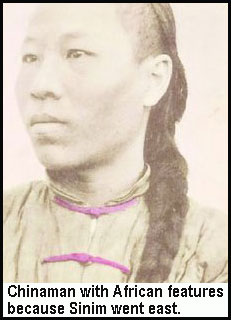
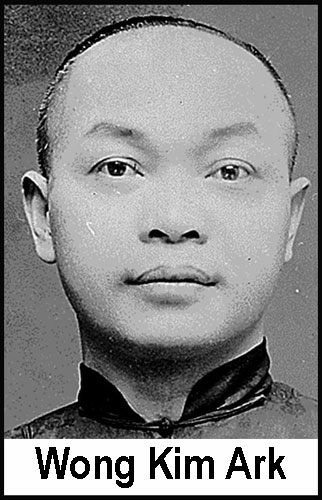
SINITES, sons of Canaan, gave their name to the "Wilderness of SIN" and "Mount SINAI" originally. They migrated north to SINOPE on the shores of the Black Sea and to the Don River which was known as the SINUS (Pliny 6:2:6). An Assyrian deity who established "laws and justice" among men according to Ur's monuments was known as "SIN" (ancestor worship). But his descendants moved eastward to the Desert of SIND in NW India. The Indus River was originally the SINDUS (Ancient India as Described by Ptolemy by McCrindle, p.82). They became the most eastern nation in the world according to Ptolemy (Lempriere's Class. Dict., p.585). "Nations of the SINAE lie at the extremity of the habitable world, and adjoin the eastern Terra Incognita" said Marcianus of Heraclea (6:188d). Passing through China, these WHITE people gave their name to that region also. Chinese call themselves TSIN and even today China is identified by the prefix "SINO-" and we see SIAN, SINKIANG, SHANGHAI, SHENSI, SHANTUNG, SHEN-YANG, TIENTSIN, FU-SHUN, SINGAPORE etcetera. But Isaiah 49:12 mentions the land of "SINIM" as an easterly location from where Israelites (WHITES) are gathered. The vulgate renders "Sinim" as "AUSTRALI." AUSTRALIA was known to the Arabs as"Terra Australis before the white man came. But today the WHITE Caucasian Israelites are found in AUSTRALIA, but the SINITES may have amalgamated with CHINA or stayed in INDIA ("Sindhi") or CEYLON ("Singalese" are white Aryans). See 2:243 and 1:145 of the Academic American Encyclopedia. One of these countries may take AUSTRALIANS captive in the future in order for Isaiah 49:12 to be fulfilled. Many ancient maps place "SIN" in China (17:636-643).
ARVADITES, sons of Canaan, named the ARVAND (Elvend) Mountain of Persia (21:188, A2) and the ARADAN town of Persia (21:188, B1). A colony moved to ARVAD, a Phoenician port city (23:649, F3). They also dwelt off the Phoenician coast on the island of ARADUS (Ruad) and in ARAD Palestine (20:602, C6). "ARADIANS" dwelt in these areas in the first century (Strabo16:2:12-14) and named the ARADEB River of Egypt (19:695c). ARADIANS are found in the Ivory Coast (15:99a). They named the ARADZANI River (Murad Su -- E. Euphrates) in Asia Minor (2:565, B2). In Hungary we find ARVA County (3:4, F2), ARVA River (3:4, F2), ARAD County (3:4, G3), UJ-ARAD (3:4, G3) and ARAD town (O-Arad) (3:4, G3). A colony sailed to ARVA Ireland (Arvagh)(14:744, D3) and to ARVIDSJAUR Sweden (19:800, D-E 2). They had an island colony in the PERSIAN GULF area (Strabo 7:369; Brit.3:212b) and probably planted a colony in BURMA. of Mediterranean-type Canaanites. Both the city of THARRAWADDY and the IRRAWADDY river (4:840, E6) sound alot like "Yaruwaddas," the Hittite form of ARVAD) (I.S.B.E. 3:1400) who may have later inter-married with an oriental branch of GOMER to produce the DARK-skinned oriental hybrid of S.E. ASIA known as VIETNAMESE today. Ptolemy 4:5 mentions the "RUADITAE" in N. AFRICA. In Scotland are the RUADH Mts. (24:412, E1) and RUADH Mheall Mts. (24:418, C2). A S. American Indian tribe is called ARAWAKIAN (1:811d).
ZEMARITES, sons of Canaan, lived in Zemar, a Phoenician coast city ("Simyra" -- Strabo 16:2:12) but were displaced by Aradians and may have moved to "Semurium" near ROME (Cic. Phil. 6,6). They also had a colony in the PERSIAN GULF area and may have gone to INDONESIA and the PHILIPPINES where we find SEMARANG city, Java (15:284, D2) and SUMATRA island, SAMAR Province and Sea. SAMARINDA is a city in BORNEO. SAMARA a Russian province. On the Malay Peninsula is the SEMARAK River (17:473, C4). PHILIPPINOS may be the hybrid of a marriage between WHITE-skinned Zemarites and ORIENTAL "Basilii," son of Togarmah.
HAMATHITES, sons of Canaan, were called "HEMATH" (Am.6:14) and "AMATHIS" (1 Macc.12:25) was a city in Syria on the banks of the Orontes (called Hamah today). The "AMATHUSIANS" apparently moved to CYPRUS (Strabo 8:3:8) and named a city there "AMATHUS" (14:6:3; see Ptolemy 5:13.). From there a branch apparently moved to MACEDONIA (called "EMATHIA" in ancient times). A city by the same name could be found near the sea (Strabo 3:329; see map 7). Ptolemy 3:12 mentions"EMATHIA" in MACEDONIA. We also find an EMATHIA district in Turkey (20:447a).
It is clear that HAM was WHITE and his wife was BLACK, giving us the two BLACK sons, a BROWN son and a WHITE son. None of his descendants were purebred WHITE. HAM'S portion was "beyond the Gihon (Geon is the Nile in Ant.1:1:3), toward the south" and this territory was further sub-divided with "Ques (CUSH -- BLACK) toward the east, and to the west of him for Phud (PHUT -- BLACK), and to the west of him for Kainan (CANAAN -- WHITE) toward the west of the sea."MIZRAIM was REDDISH-BROWN. Yes, "the land of Ham is hot" (Jubilees 8 & 9).
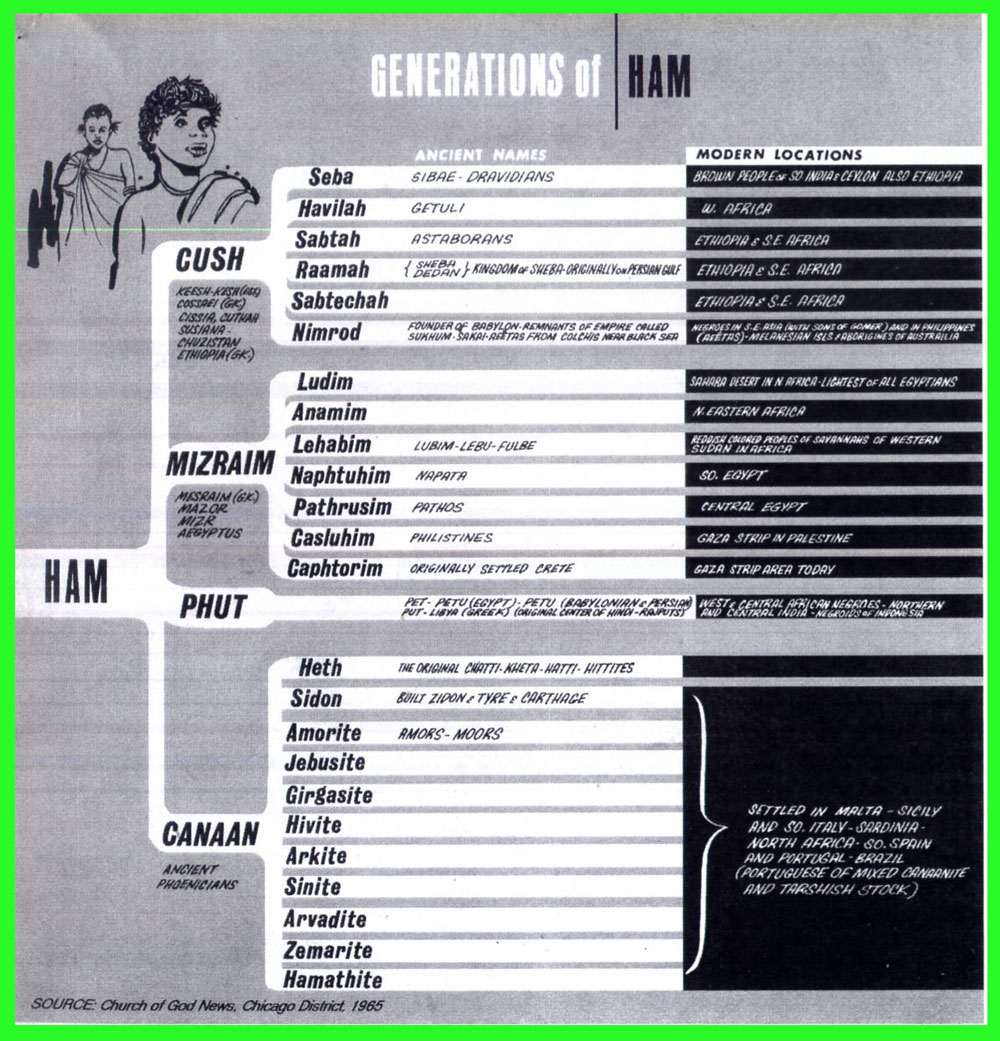
Canaan Fled From "Joshua the Robber"
From Procopius of Caesarea, "History of the Wars" Book IV, "The Vandalic War," Capt.X, 12ff (Loeb Class, London, 1916) we read, "it is necessary to tell from the beginning whence the nations of the MOORS came to Libya, and how they settled there. When the Hebrews had withdrawn from Egypt, and had come near the boundaries of Palestine, Moses, a wise man, who was their leader on the journey, died, and the leadership was passed on to Joshua, the son of Nun, who led this people into Palestine, and, by displaying a valour in war greater than that natural to a man, gained possession of the land. And after overthrowing all the nations he easily won the cities, and he seemed to be altogether invincible. Now at that time the whole country along the sea from Sidon as far as the boundaries of Egypt was called PHOENICIA. And one king in ancient times held sway over it, as is agreed by all who have written the earliest accounts of the PHOENICIANS. In the country there dwelt very populous tribes, the GERGESITES and the JEBUSITES and some others with other names by which they are called in the history of the Hebrews. Now when these nations saw that the invading general was an irresistible prodigy, they emigrated from their ancestral homes and made their way to Egypt, which adjoined their country. And finding there no place sufficient for them to dwell in, since there has been a great population in Egypt from ancient times, they proceeded to Libya. And they established numer-ous cities and took possession of the whole of Libya as far as the Pillars of Heracles, and there they have lived even up to my time, using the PHOENICIAN tongue. They also built a fortress in Numidia, where now is the city called Tigisis. In that place are two columns made of white stone near by the great spring, having PHOENICIAN letters cut in them which say in the PHOENICIAN tongue: 'We are they who fled from before the face of Joshua, the robber, the son of Nun.' There were also other nations settled in Libya before the MOORS, who on account of having been established there from of old were said to be children of the soil. And because of this they said that Antaeus, their king, who wrestled with Heracles in Clipea (i.e. Clypea, or Aspis, now Kalibia, on the Carthaginian coast) was a son of the earth. And in later times those who removed from PHOENICIA with Dido came to the inhabitants of Libya as to kinsmen. And they willingly allowed them to found and hold Carthage. But as time went on, Carthage became a powerful and populous city. And a battle took place between them and their neighbors, who, as has been said, had come from Palestine before them and are called MOORS at the present time, and the Carthaginians defeated them and compelled them to live a very great distance away from Carthage. Later on the Romans gained the supremacy over all of them in war, and settled the MOORS at the extremity of the inhabited land of Libya, and made the Carthaginians and the other Libyans subject and tributary to themselves. And after this the MOORS won many victories over the Vandals and gained possession of the land now called Mauretania, extending from Gadira as far as the boundaries of the Caesarea (i.e. from Tangier, opposite Cadiz, to Algiers....) as well as the most of Libya which remained. Such, then, is the story of the settlement of the MOORS in Libya."
The famous Augustine of Hippo, in North Africa, called himself a Canaanite and stated that the inhabitants of Carthage called themselves Canaanites even in the fifth century A.D. (The Phoenicians and the West by Aubet, p.10).
In Josephus, Antiquities book V, chapter 1, section 29, Whiston wrote in a footnote, "Since not only Procopius and Suidas, but an earlier author, Moses Chorenensis, and perhaps from his original author Mariba Catina, one as old as Alexander the Great, sets down the famous inscription at Tangier concerning the old Canaanites driven out of Palestine by Joshua, take it here in that author's own words 'We are those exiles that were governors of the Canaanites, but have been driven away by Joshua the robber, and are come to inhabit here.' Nor is it unworthy of our notice that Moses Chorenensis adds, viz., that 'one of those eminent men among the Canaanites came at the same time into Armenia, and founded the Gethunian family, or tribe; and that this was confirmed by the manners of the same family, or tribe, as being like those of the Canaanites." Many of these Canaanites have become "hewers of wood and drawers of water" (Josh.9:21) even up to our day today. They were pushed out of Palestine, then pushed out of Algeria and Morocco, then as Moors were pushed out of Spain back to Algeria and Morocco.
Israelite Phoenicians?
The name PHOENICIAN derived from Phoenice, which means RED or PURPLE. Professor Rawlinson says, "the Canaanites and Phoenicians were TWO distinct RACES, the former being the original occupants of the country, and the latter being IMMIGRANTS at a comparatively recent date." Judges 5:17 says, "Why did Dan remain in ships? Asher continued on the seashore." Then Judges 1:31 says "Asher did not drive out the inhabitants ... but the Asherites dwelt among the Canaanites." The name Phoenicians derived from Phoenice, which means red or purple. Professor Rawlinson says "the Canaanites and Phoenicians were two distinct races, the former being the original occupants of the country, and the latter being immigrants at a comparatively recent date." Rawlinson places the immigration in the thirteenth century B.C. (1200-1300)since "It is sufficiently early to accord with the Greek traditions, which made the Phoenicians predominant in the Eastern Mediterranean at the time of the Trojan war, and spoke of their settlement in Boeotia at a period still earlier. And it is sufficiently late to harmonize with scripture, which does not introduce to our notice the real artistic and commercial Tyrians and Sidonians till the reigns of David and Solomon. Ezekiel 27 mentions "Dan also and Javan going to and fro occupied in her fairs." The Phoenicians were known for their purple dyes. Exodus 35:34-35 explains how they came to be experts: "He (the Lord) hath put in his (Bezaleel's) heart that he may teach; both he and Aholiab, the son of Shisamach, of the Tribe of Dan, them hath he filled with wisdom of heart, to work all manner of work, of the engraver, and of the cunning workman, and of the embroiderer, in blue and in purple, in scarlet and in fine linen, and of the weaver, even of them that do any work, and of those that devise cunning work." (see also Ex. 38:23) In 2 Chronicles 2:13 mentions another Danite "skilful to work in gold, and in silver, in brass, in iron, in stone, and in timber, in purple, in blue, and in fine linen, and in crimson; also to grave any manner of graving."
The Phoenicians also taught the Greeks and Romans letters and writing. Gesenius has shown, from numerous coins and inscriptions, the intimate connection between the Phoenician and other languages of the Semitic nations. The letters of the Phoenician alphabet closely resemble those of the Samaritan. Also Jerome represents the Phoenician language as allied to the Hebrew, and he says the same of the Punic, which, however, he observes was more remote from the mother tongue. Greeks learned writing from Phoenicians who learned from Israelites who learned from God. Exodus 31:18 says, "He gave unto Moses, when he had made an end of communing with him upon Mount Sinai, two tables of testimony, tables of stone, written with the finger of God." Then Exodus 32:16 says, "the writing was the writing of God." Then Moses broke the tables and "The Lord said unto Moses, Hew thee two tables of stone like unto the first; and I will write upon these tables the words which were in the first tables which thou breakest." After giving Moses more instructions, the Lord said to him "Write thou these words" (Ex. 34:27).
Therefore, the Phoenicians were Israelites of the tribes of Asher and Dan who owed their success in trade skills and writing to Aholiab and Moses who were taught by God. Jacob thereby "supplants" Canaan with superior technology just as his name "Jacob" means "supplanter." Canaan was the first in a long line of evil nations that God wanted to be "supplanted" by Israel.
Israel and Phoenicia spoke different dialects of the same Hebrew language and so could understand eachother. Inscriptions of Phoenicia and Carthage from about the 9th century B.C. onwards were written in a Semitic dialect and inscribed in the reversed or retrograde direction, from right to left, with reversed letters, as adopted by Semitic tribes. The Phoenician alphabet was also "Semitic." Herodotus specially records that while the residents in Phoenicia, who were mainly Semites, practiced circumcision, the Phoenician mariners, who were mainly the Hamitic true Phoenicians, were uncircumcised (Her.2:104). Therefore, we see that the alphabet and writings were probably Israelite inventions which the Phoenicians borrowed. This is why historians think the Phoenicians were Shemite rather than Hamite. The monuments and coins of the Mediterranean Phoenicians show them to be of fine Caucasian Aryan physical type so these are portrayals of purebred Israelites. Hiram and David had conversations (2 Sam. 5:11). Solomon hired many workers from Phoenicia (1 Ki.5:6). Elijah and the Sidonian widow conversed (1 Ki.17:9-16) and the two navies had a joint expedition (1 Ki.9:26-28). Some scholars have speculated that the friendship and alliance between Hiram and David and later with Solomon (2 Sam.5:11; 1 Ki.5) implies that many Phoenician colonies were actually Israelite colonies such as "Gades" Spain where the tribe of GAD had a colony and MARSEILLE and BRITAIN, named after Brutus-the-Trojan who was from Zarah Judah (see p.155 of Waddell's Phoenician Origin of Britons). Even up to the first century, Phoenicia was at peace with and dependent upon Palestine for food (Acts 12:20). Perhaps many Israelites escaped Assyrian captivity in 721 B.C. by sailing to GADES, MARSEILLE and BRITAIN since Sargon II only led away captive a mere 27,290 Israelites from Samaria (p.263. Bible As History).
Thus Israelites became known as Phoenicians and gave them their Shemitic language and alphabet. Many Phoenician coins have the consonants "B-R-T" on them, meaning "Covenant" (People) in Hebrew. From BEIRUT Lebanon (Ptolemy 5:14) they sailed to Cappadocia where we find the town of "Barattha" (Ptolemy 5:6). Their next stop was probably "Bruttium, the southernmost point of Italy" (Pliny 3:38). From this Phoenician colony these Israelite Phoenicians finally settled in BRITAIN which later expanded into the BRITISH Empire and the UNITED STATES. More on this later.
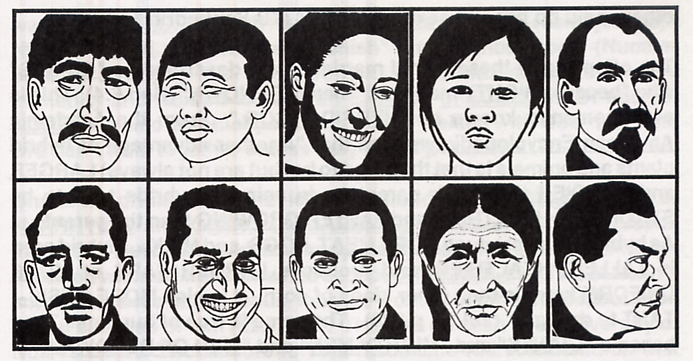
Next Lesson: The Amazing HISTORY of the World's RACES (part two) | Back to Home | Email Us
